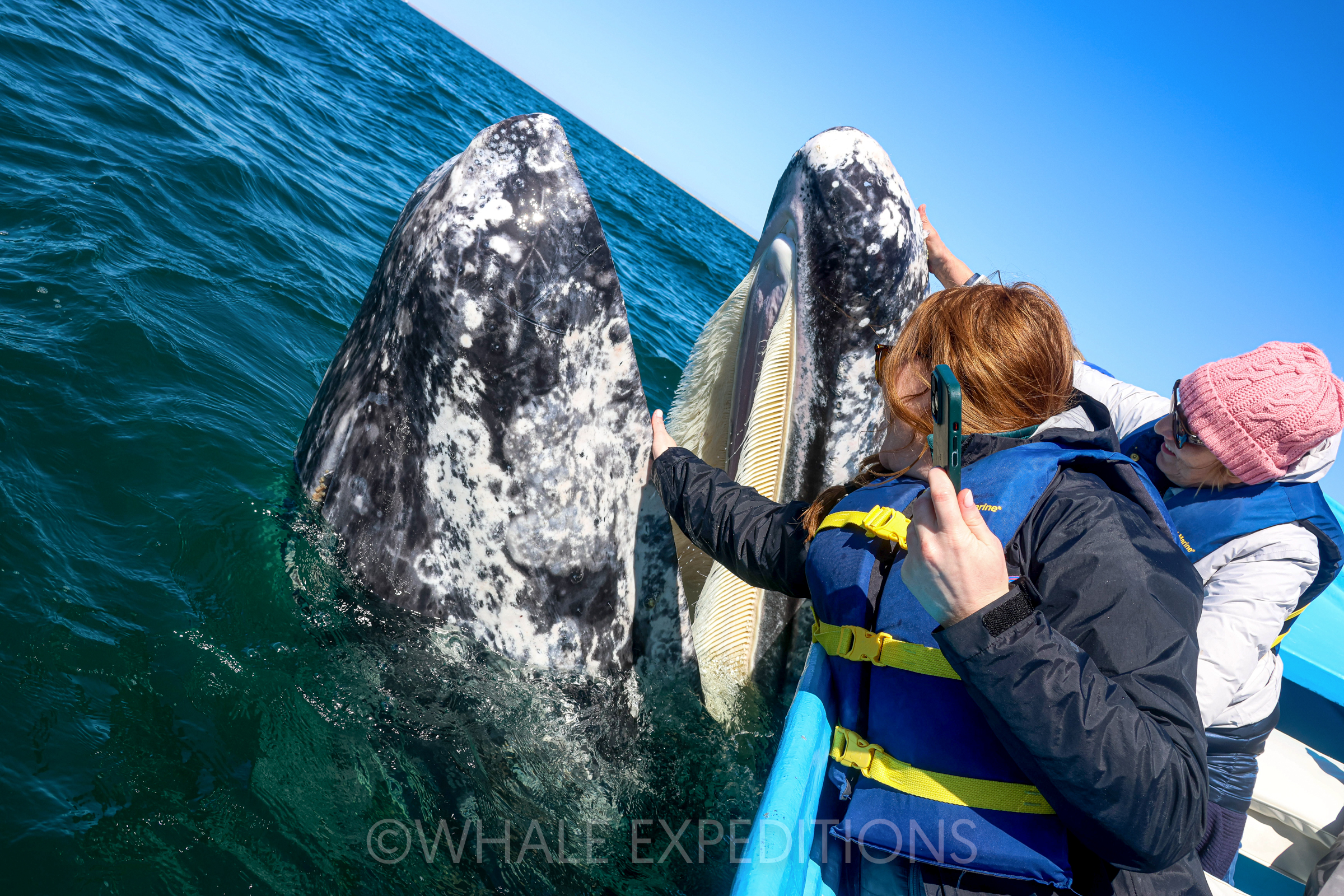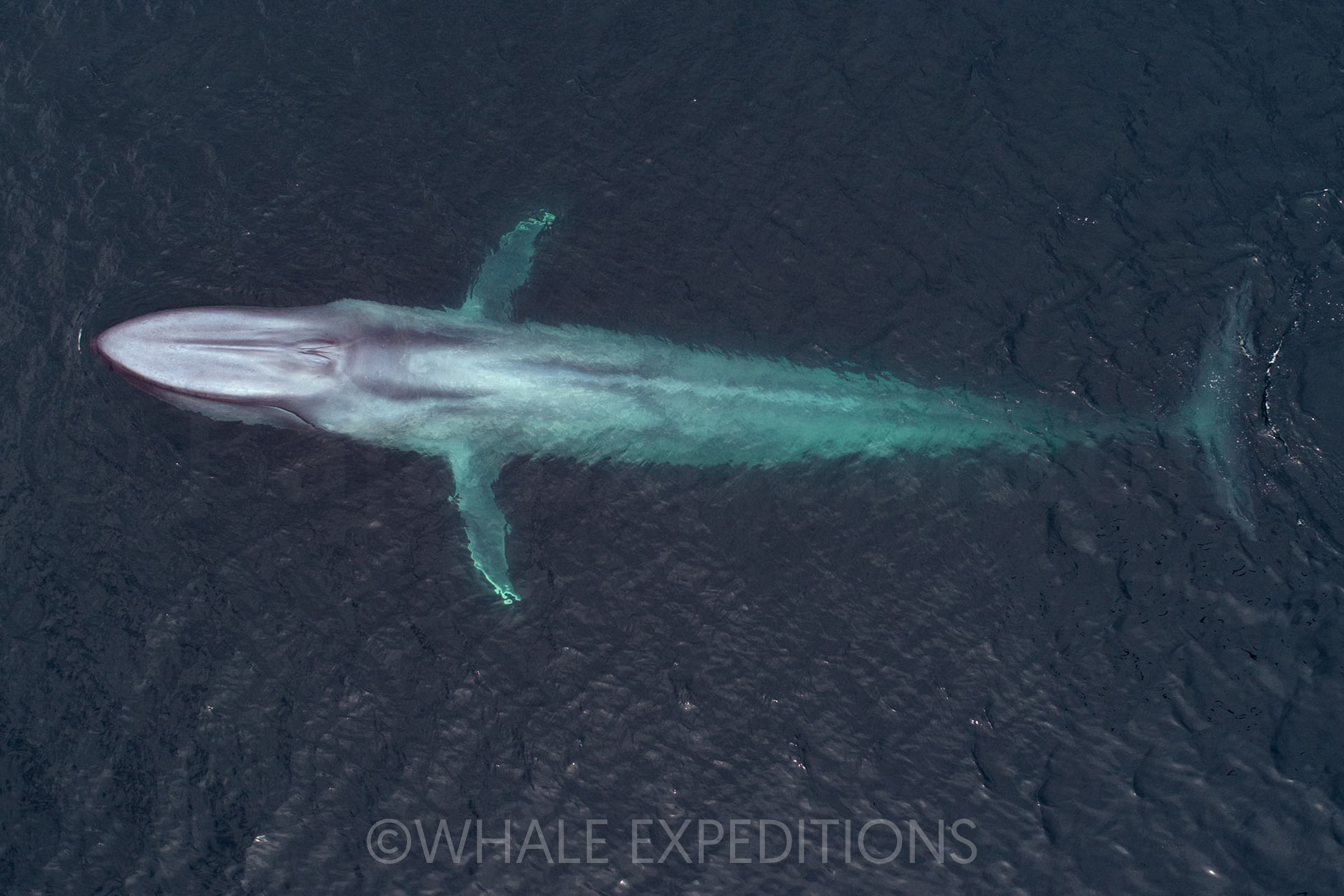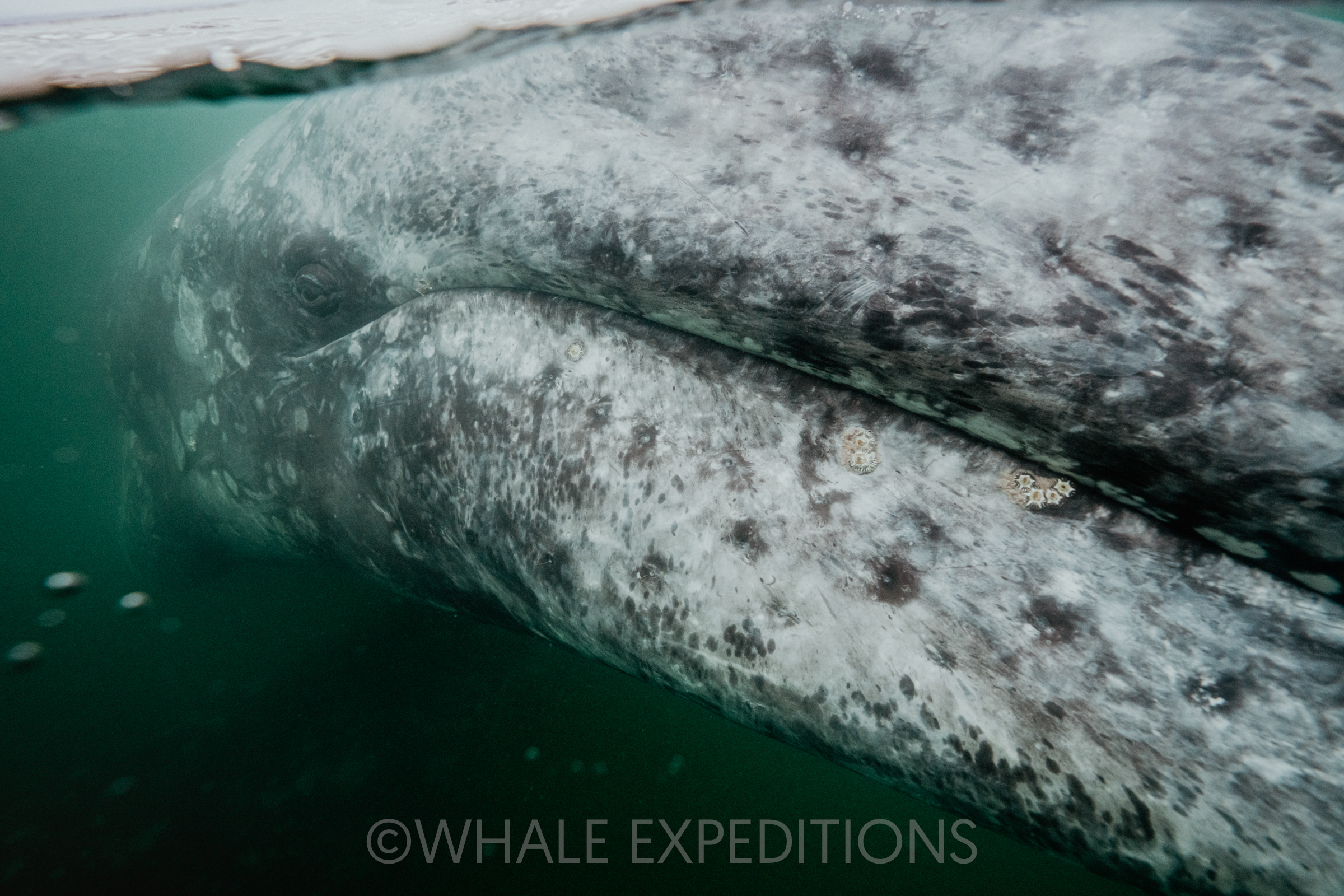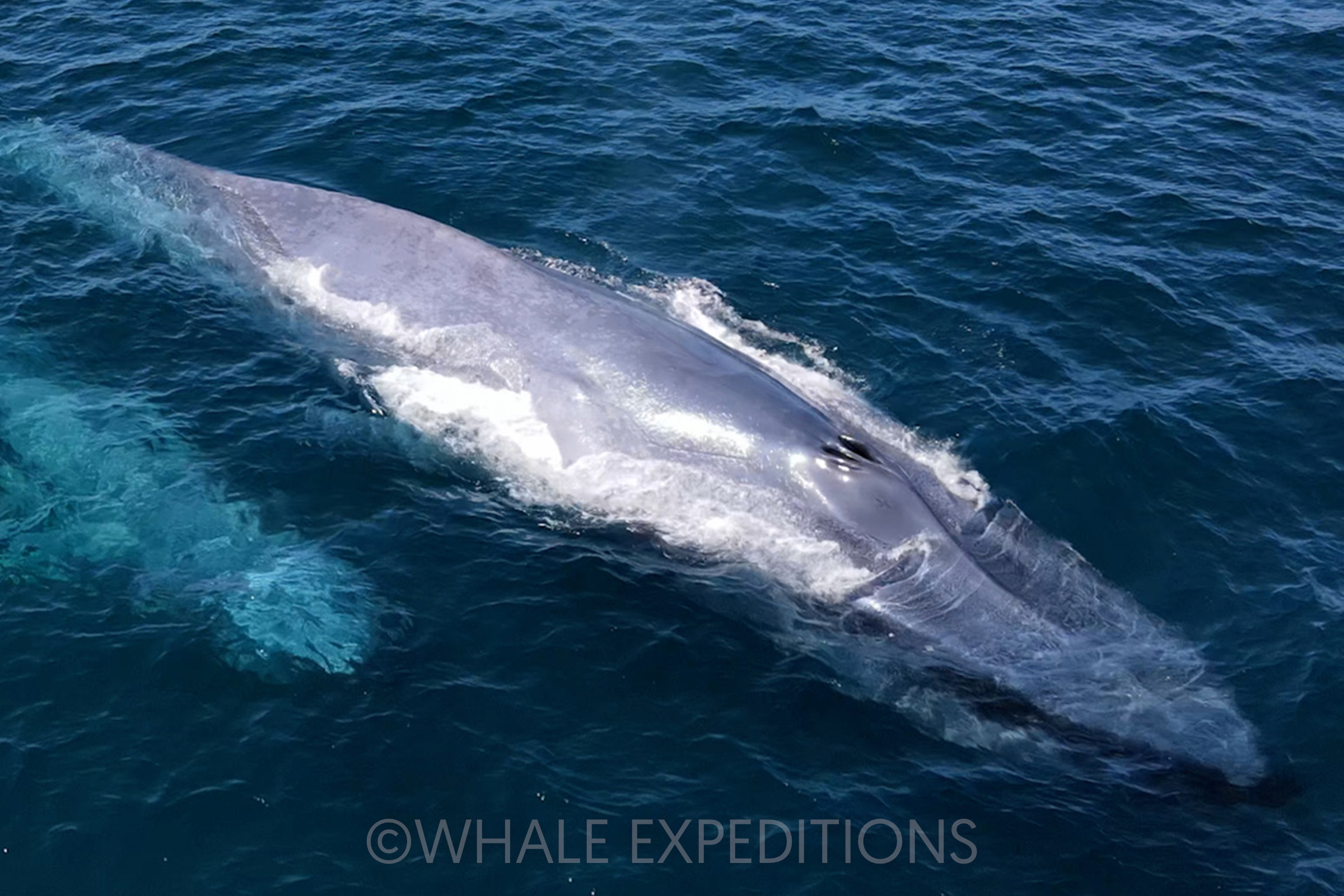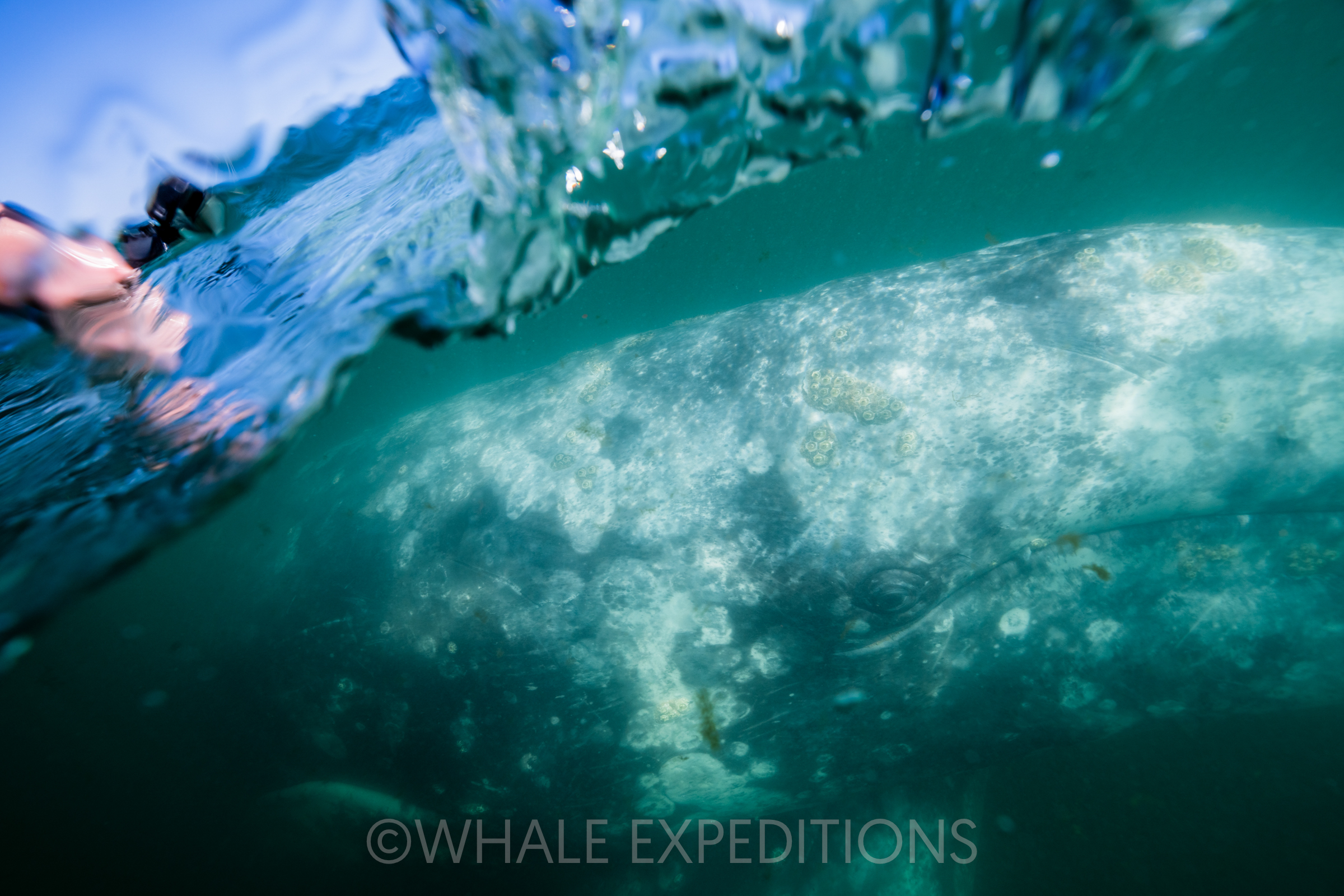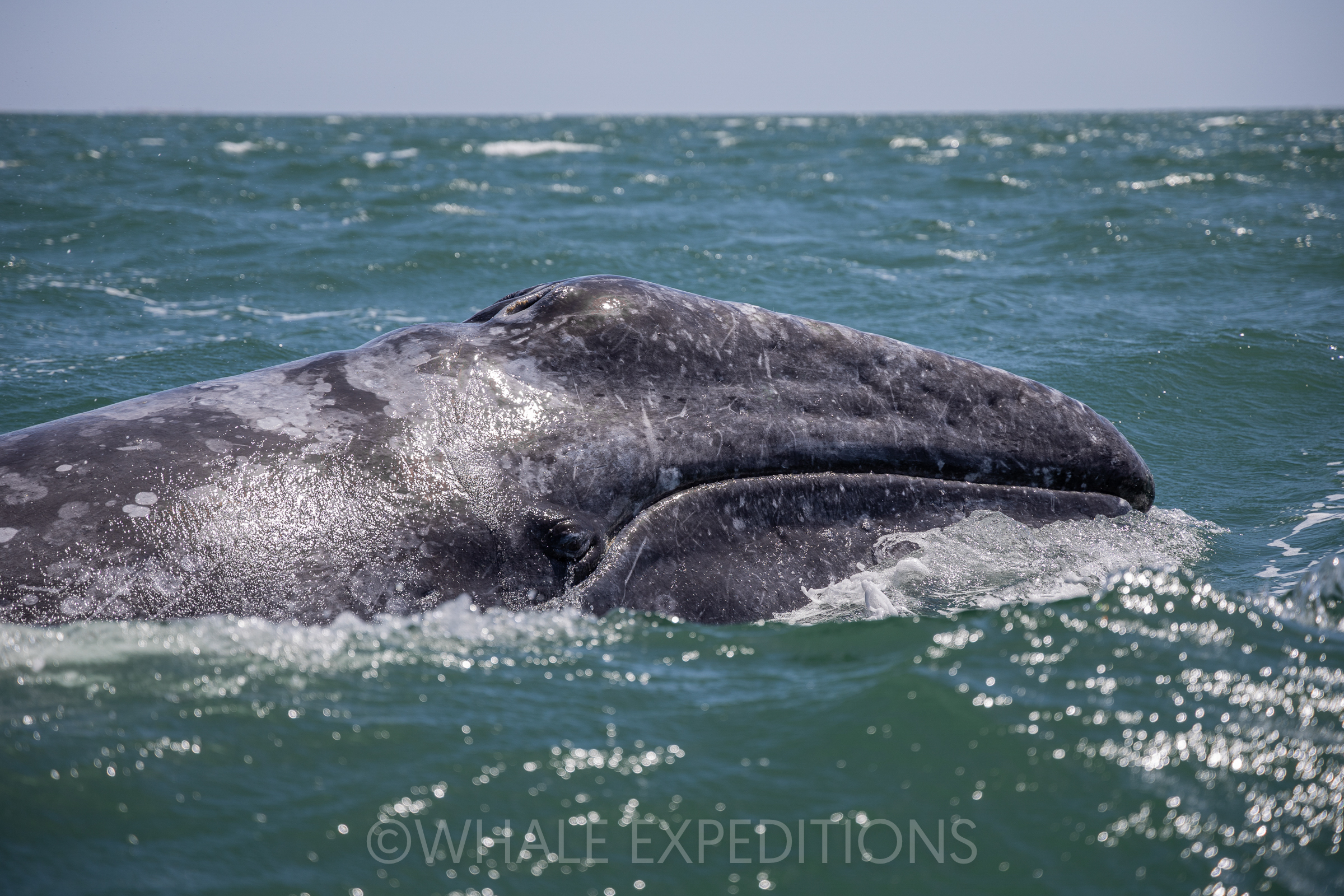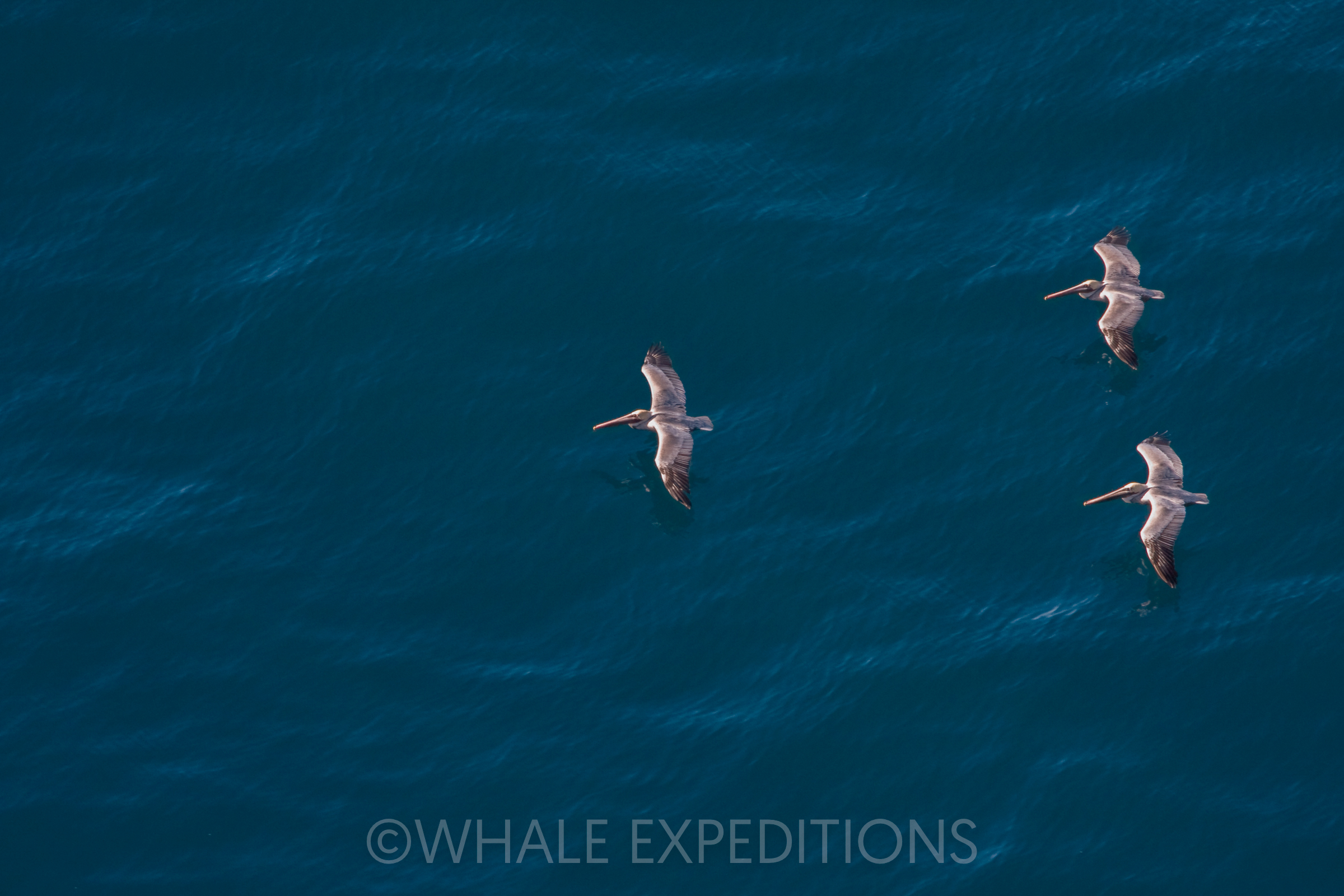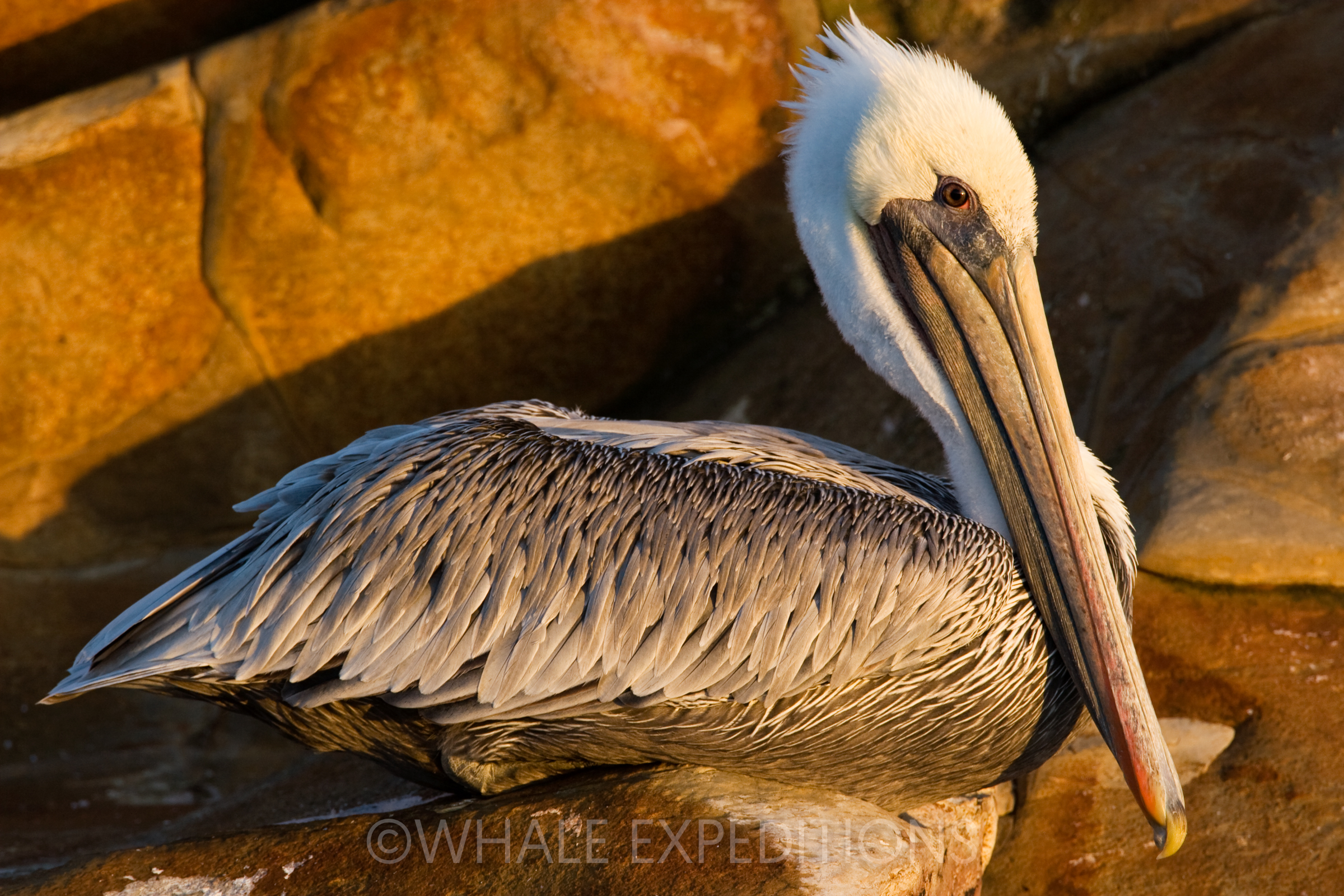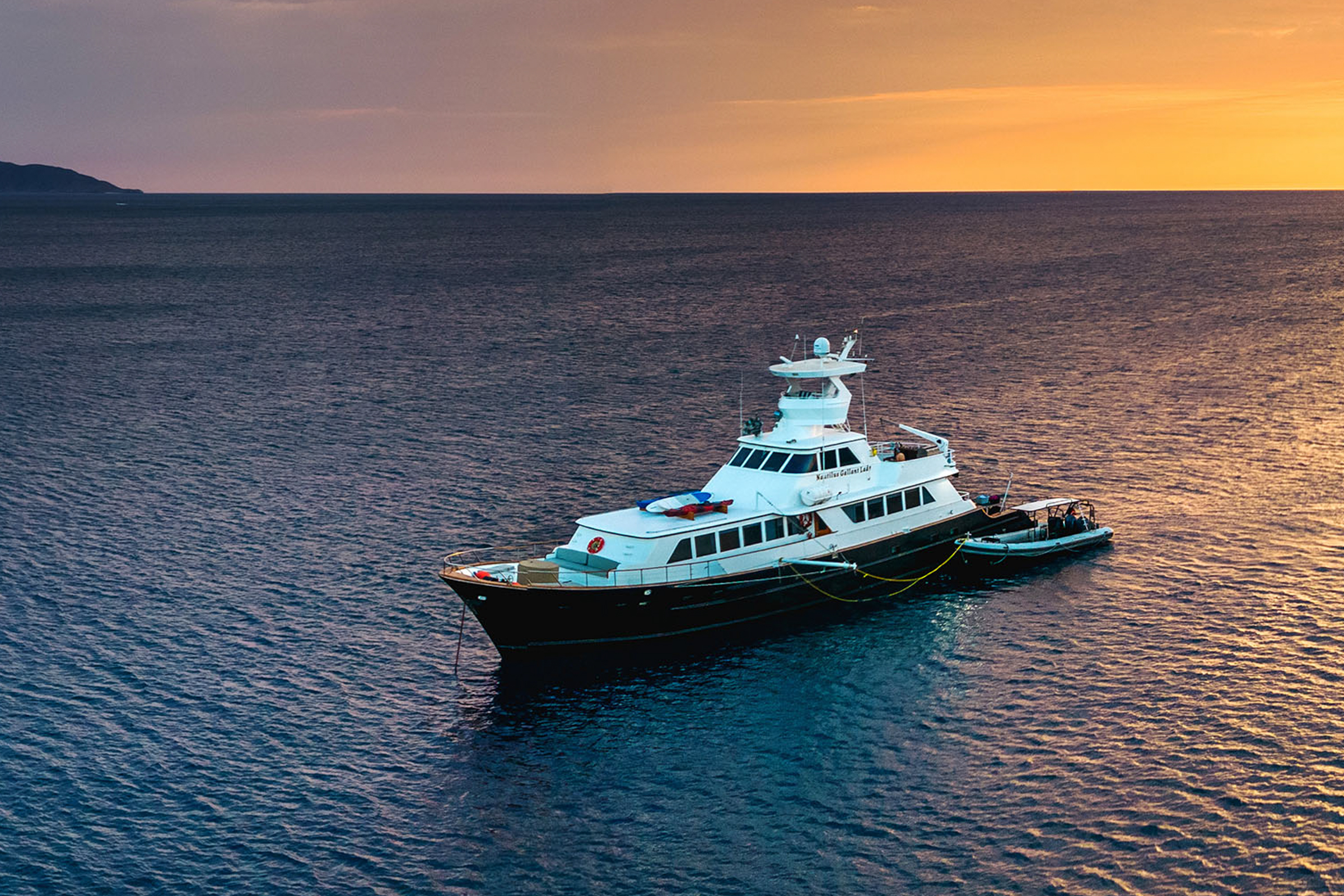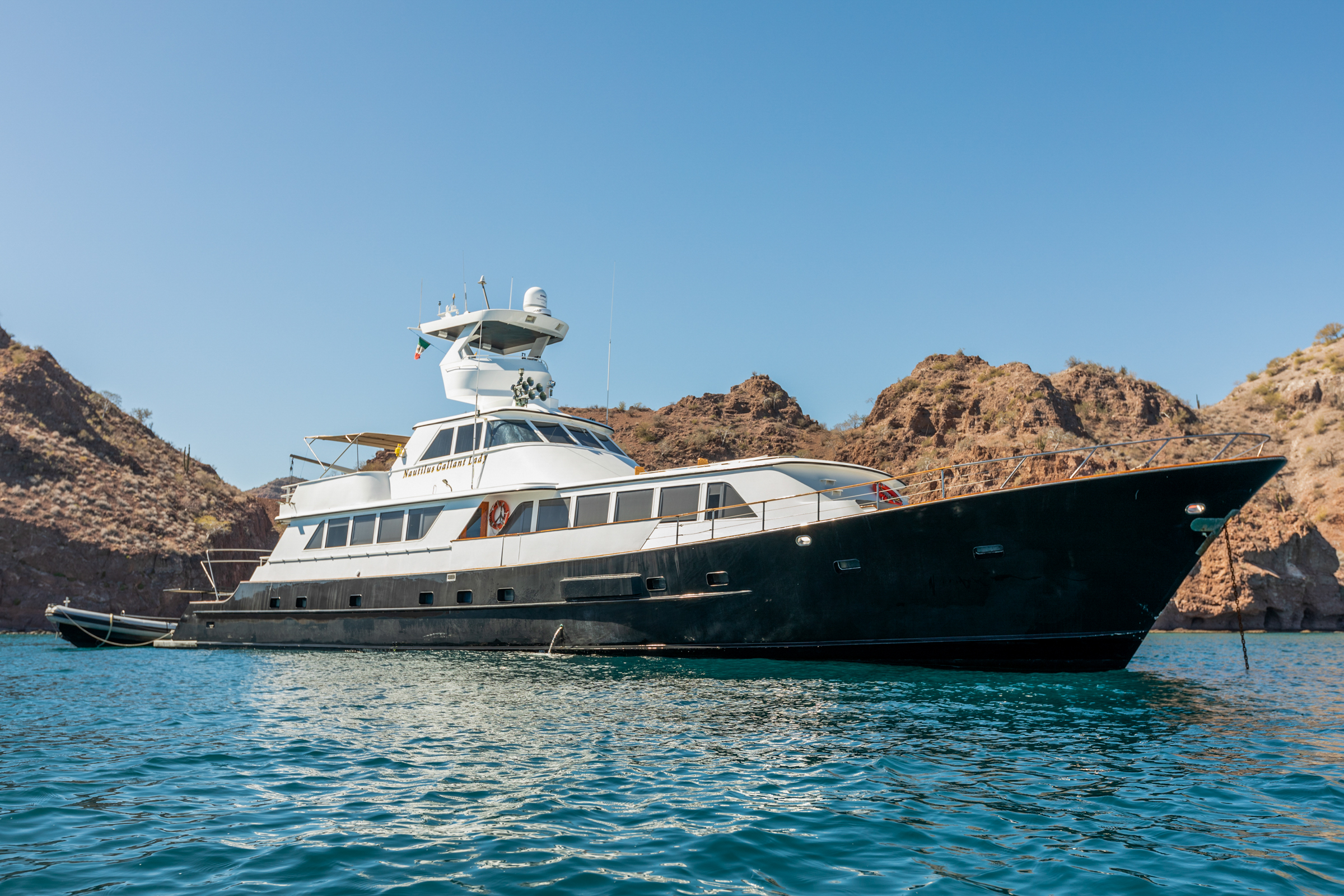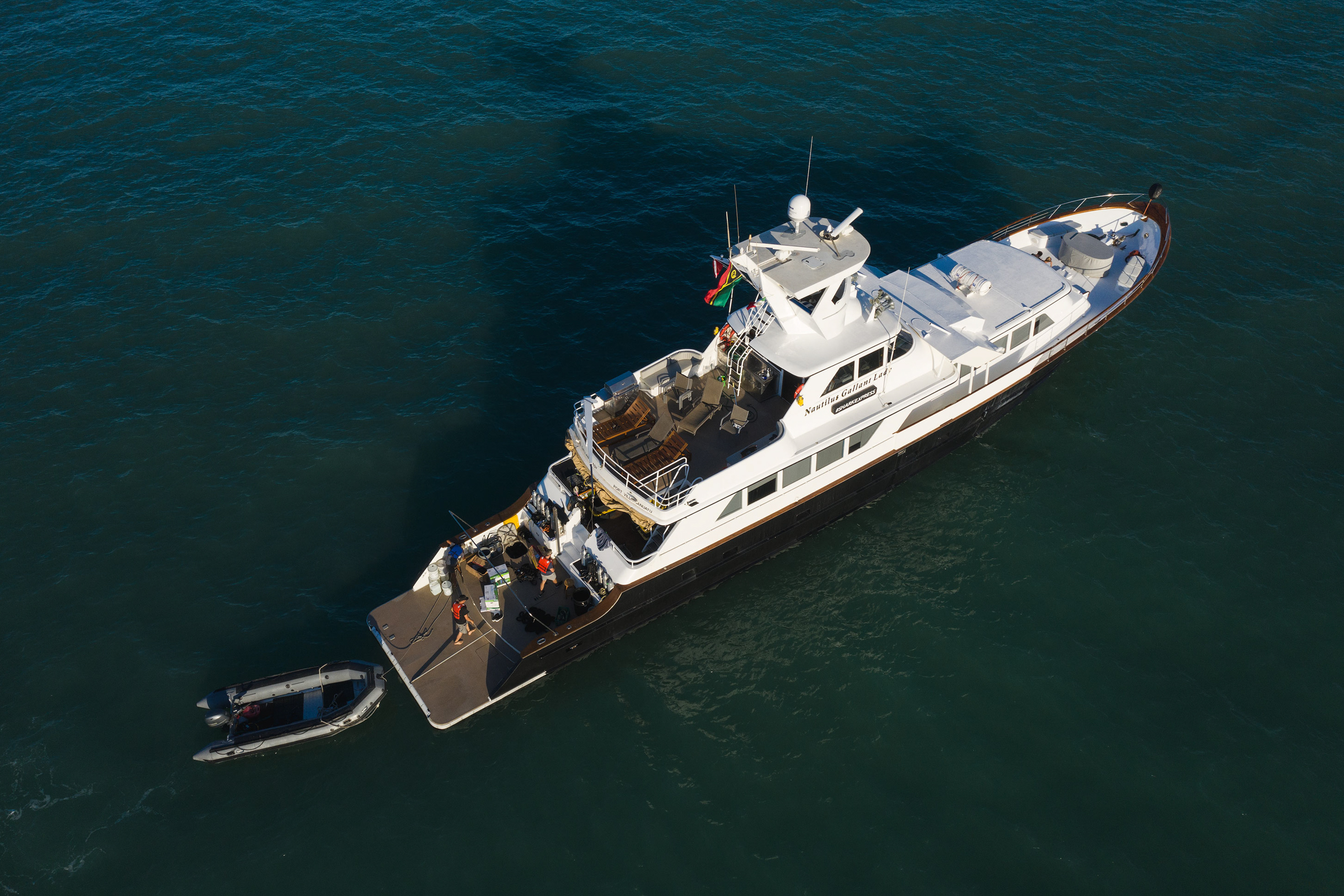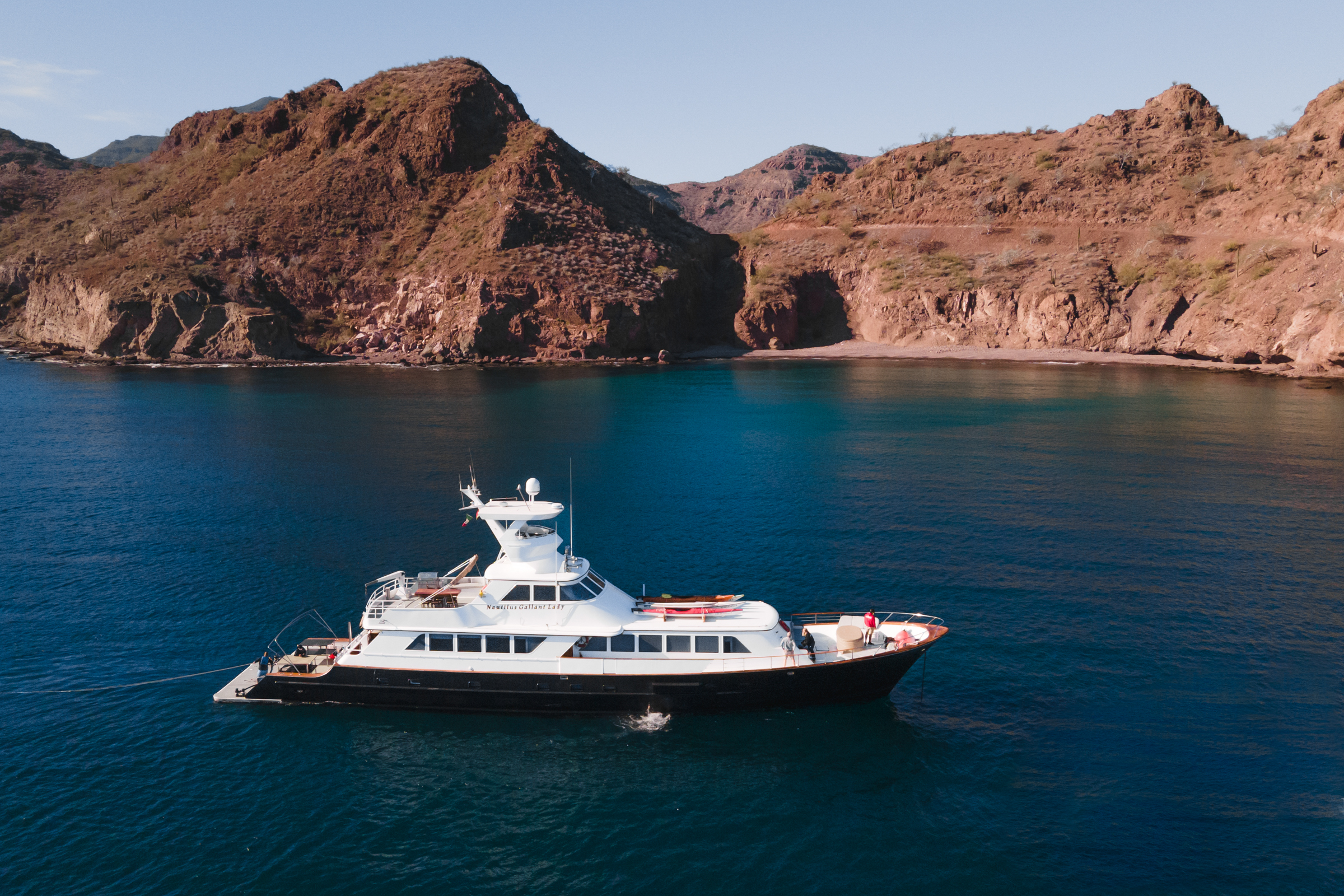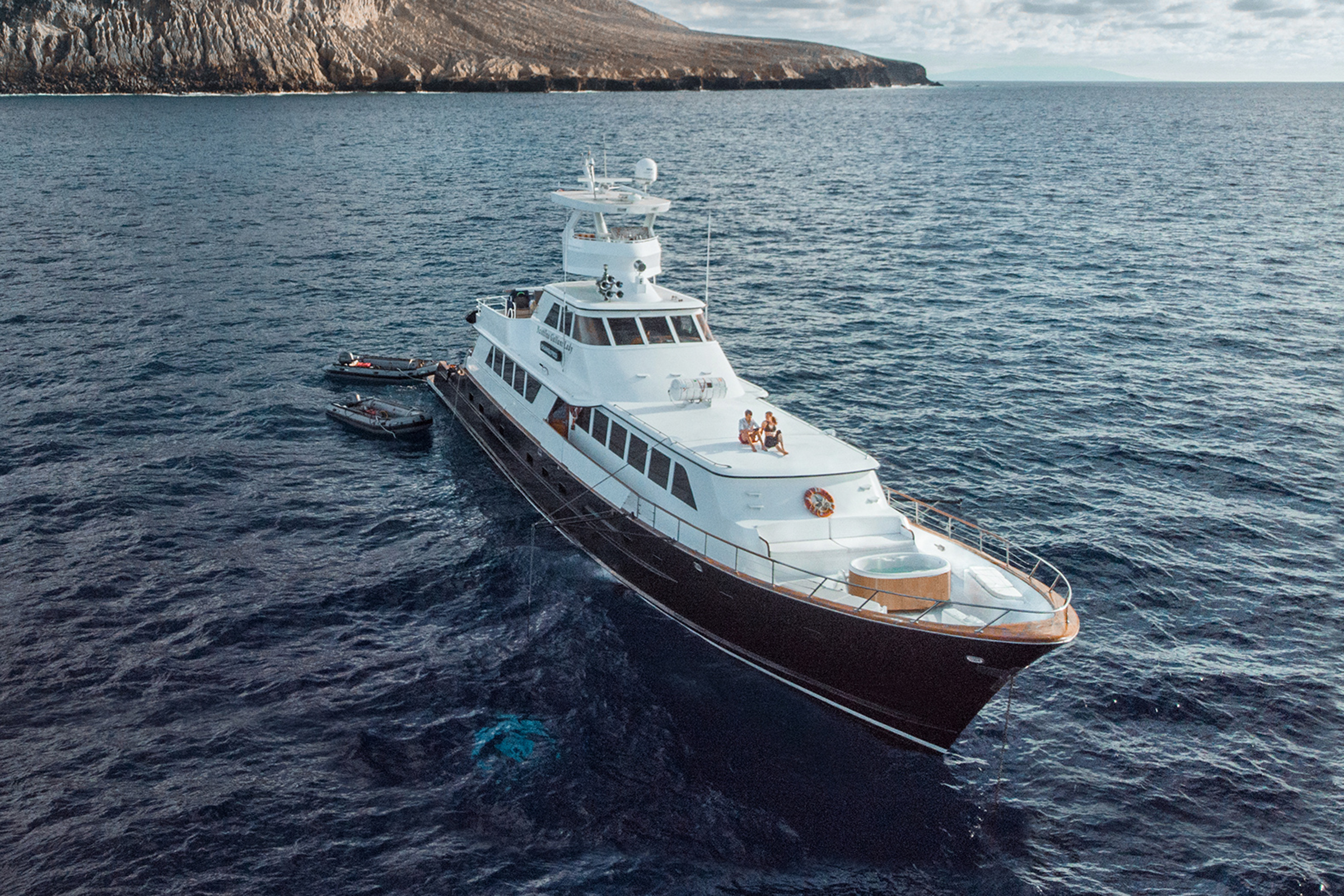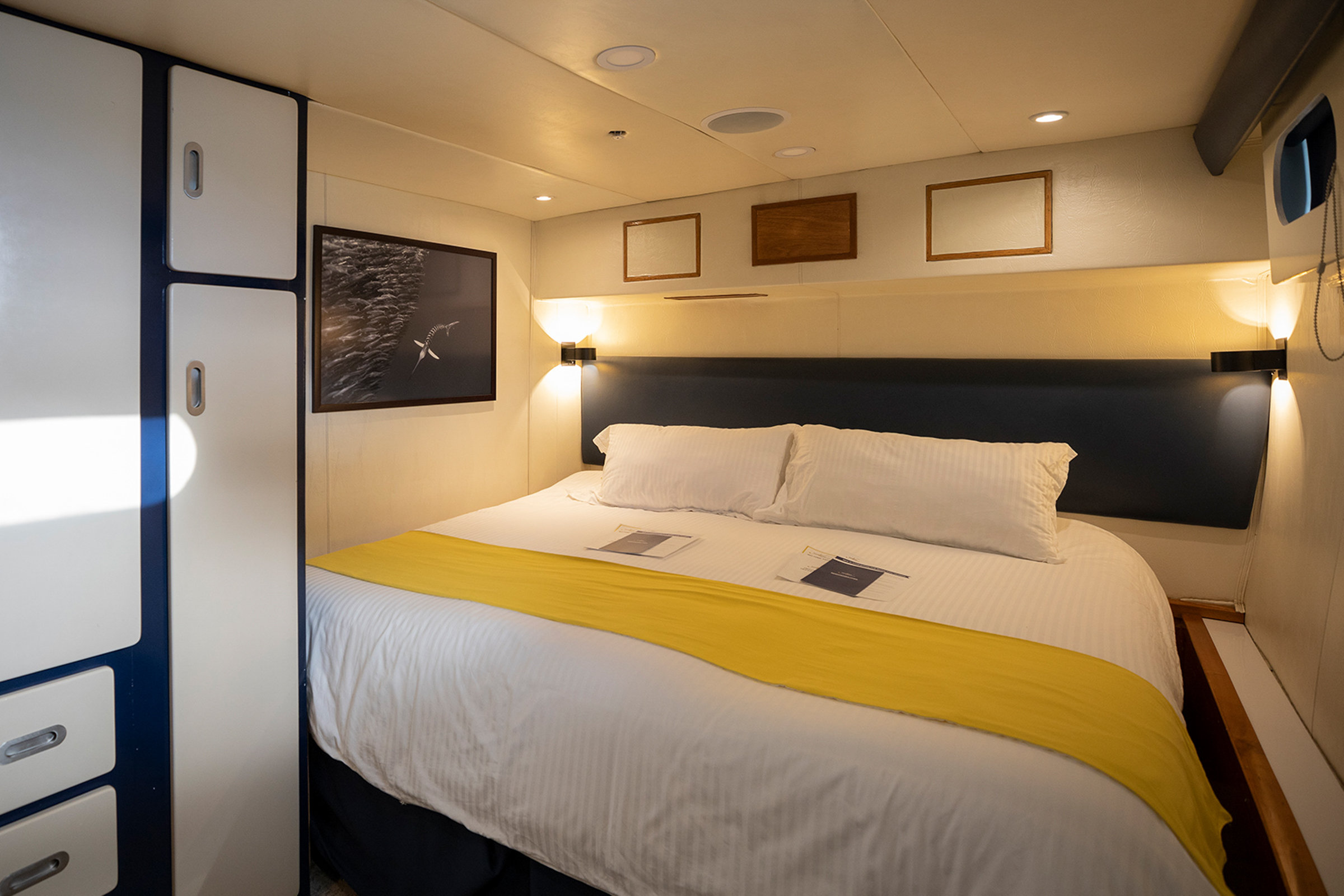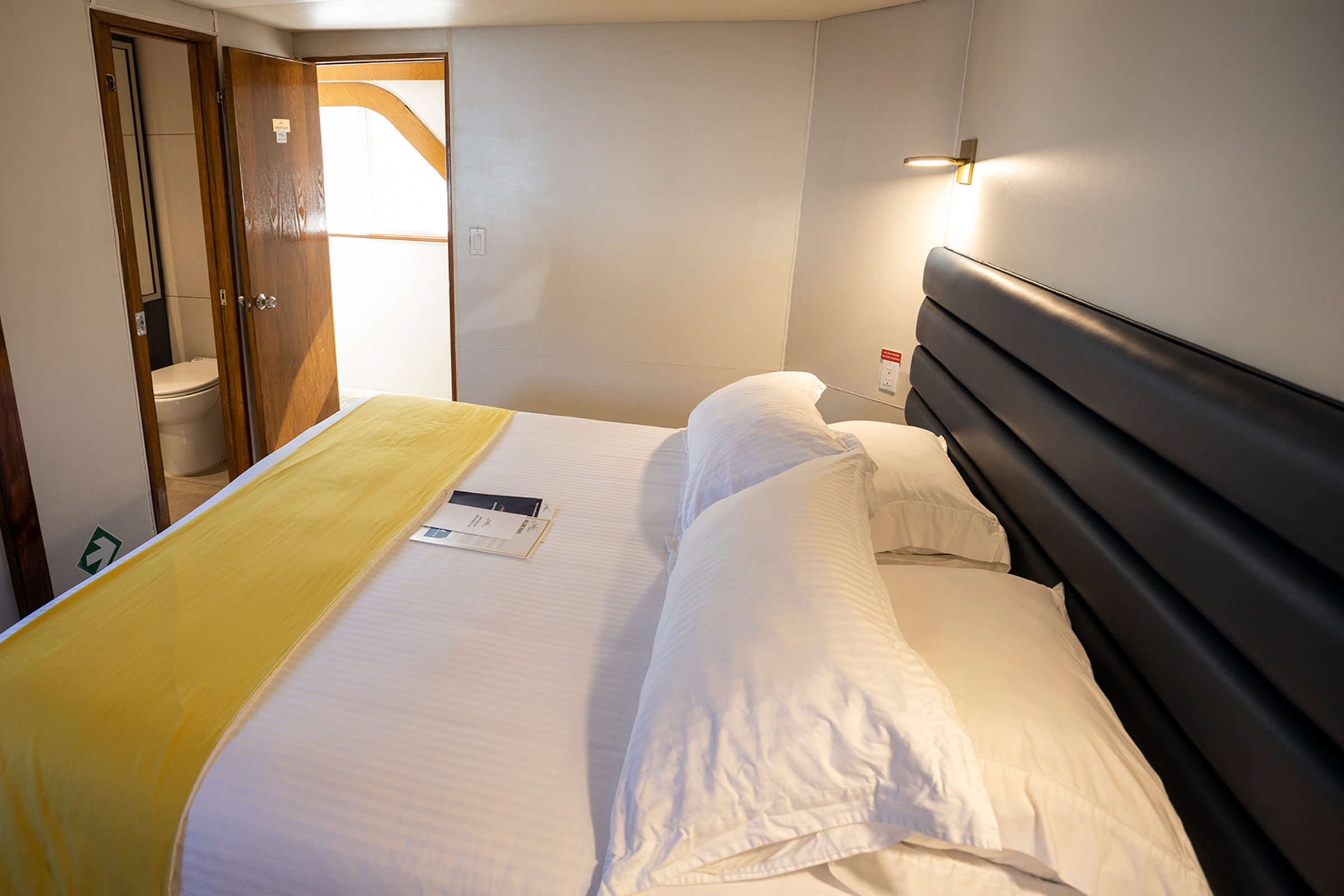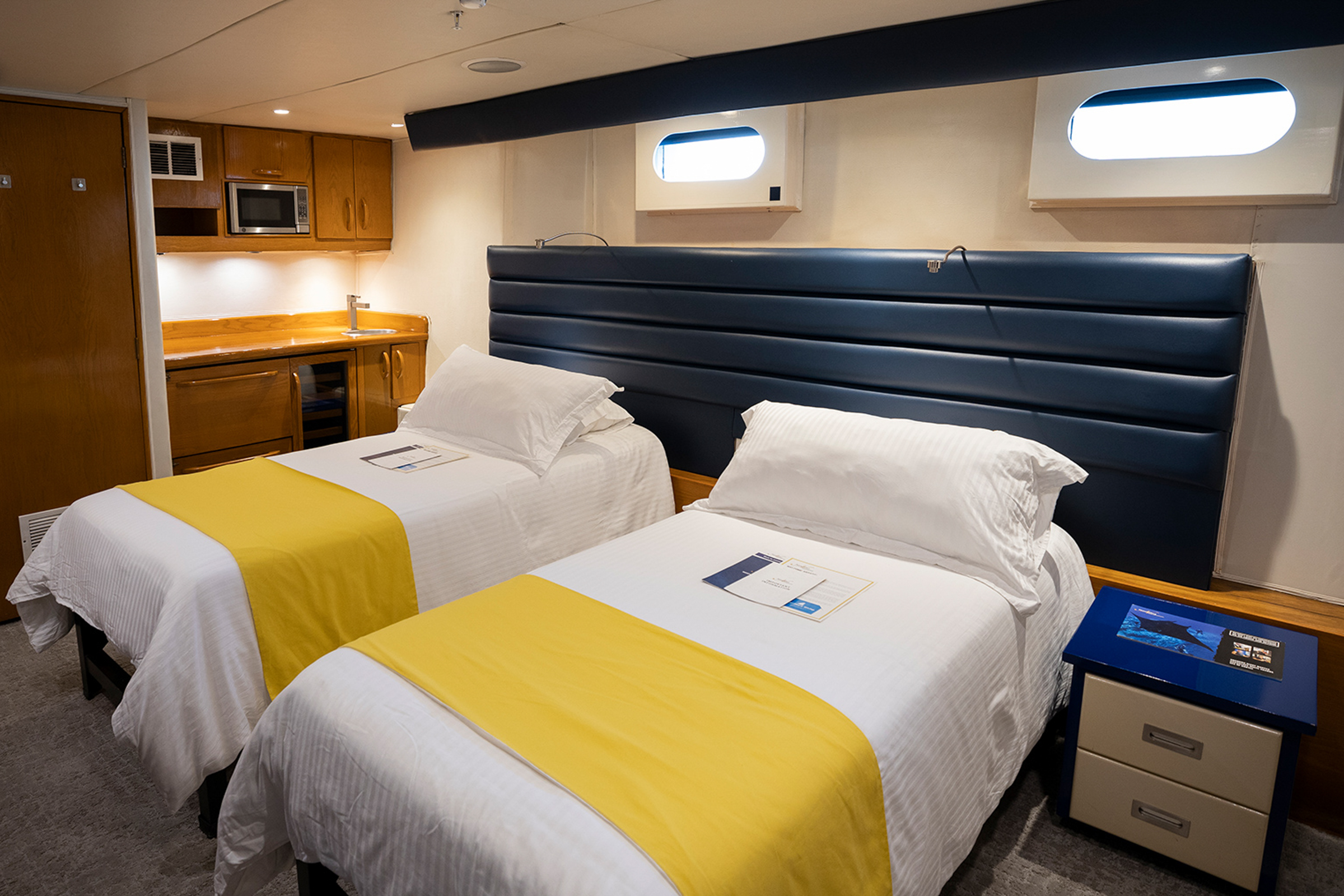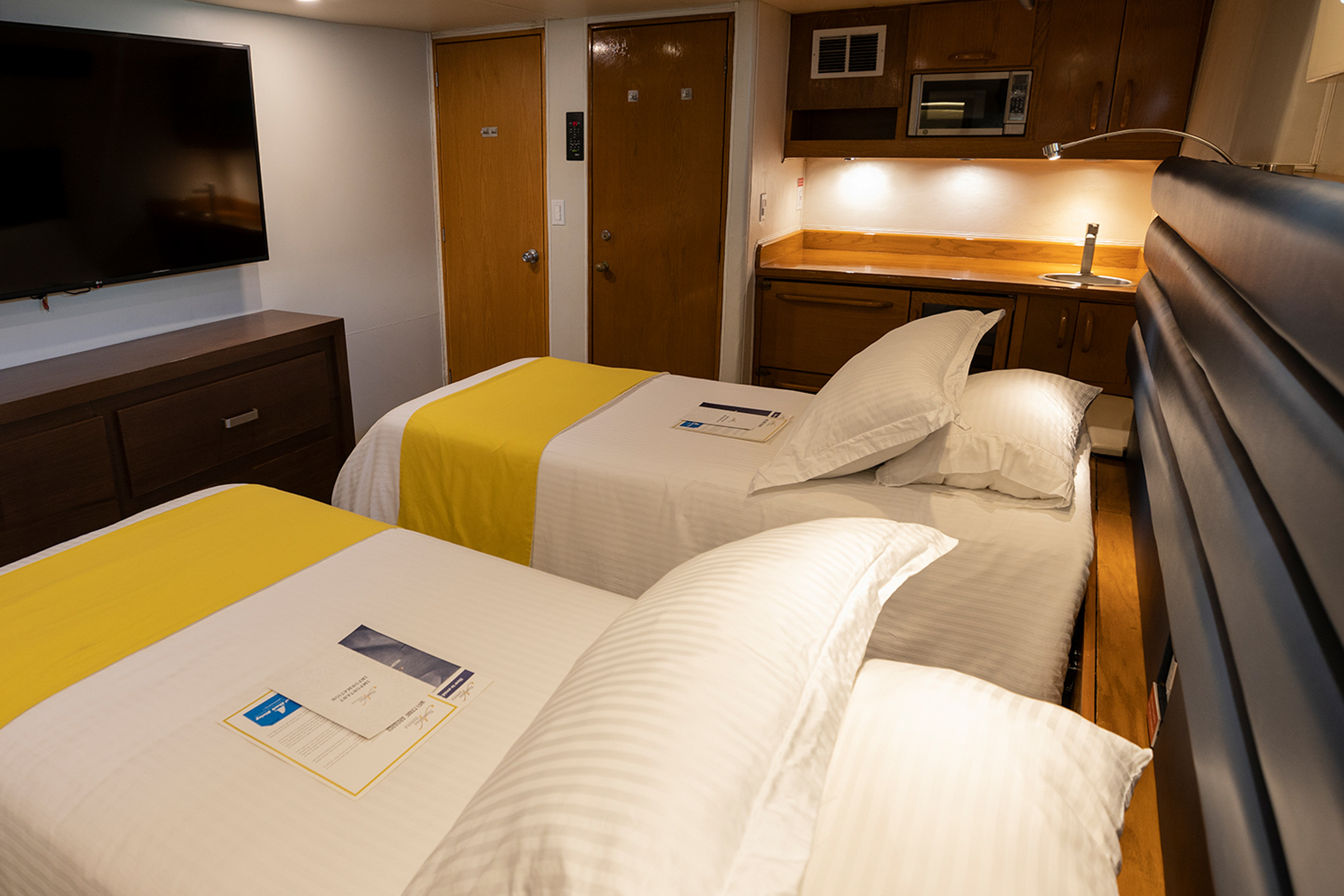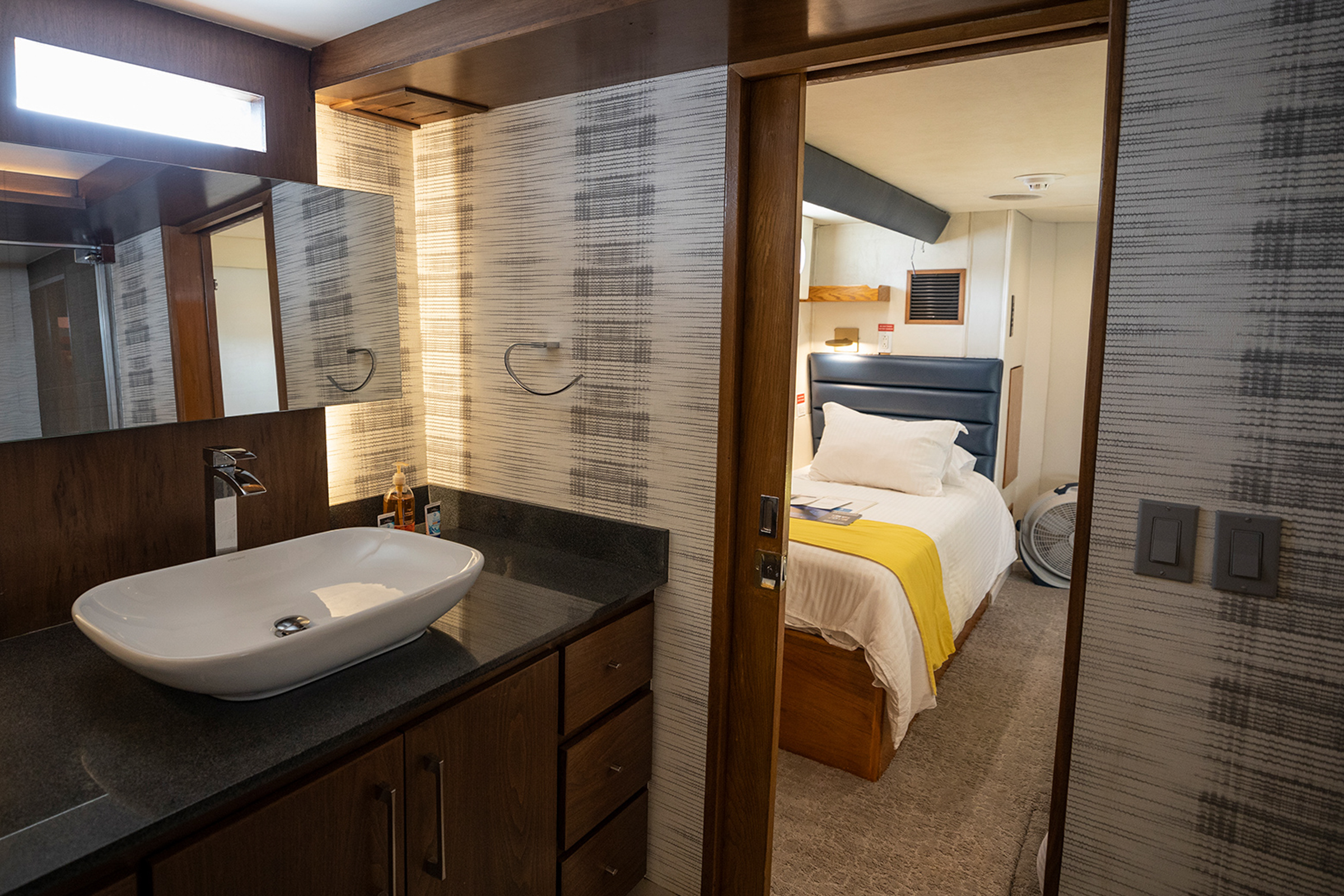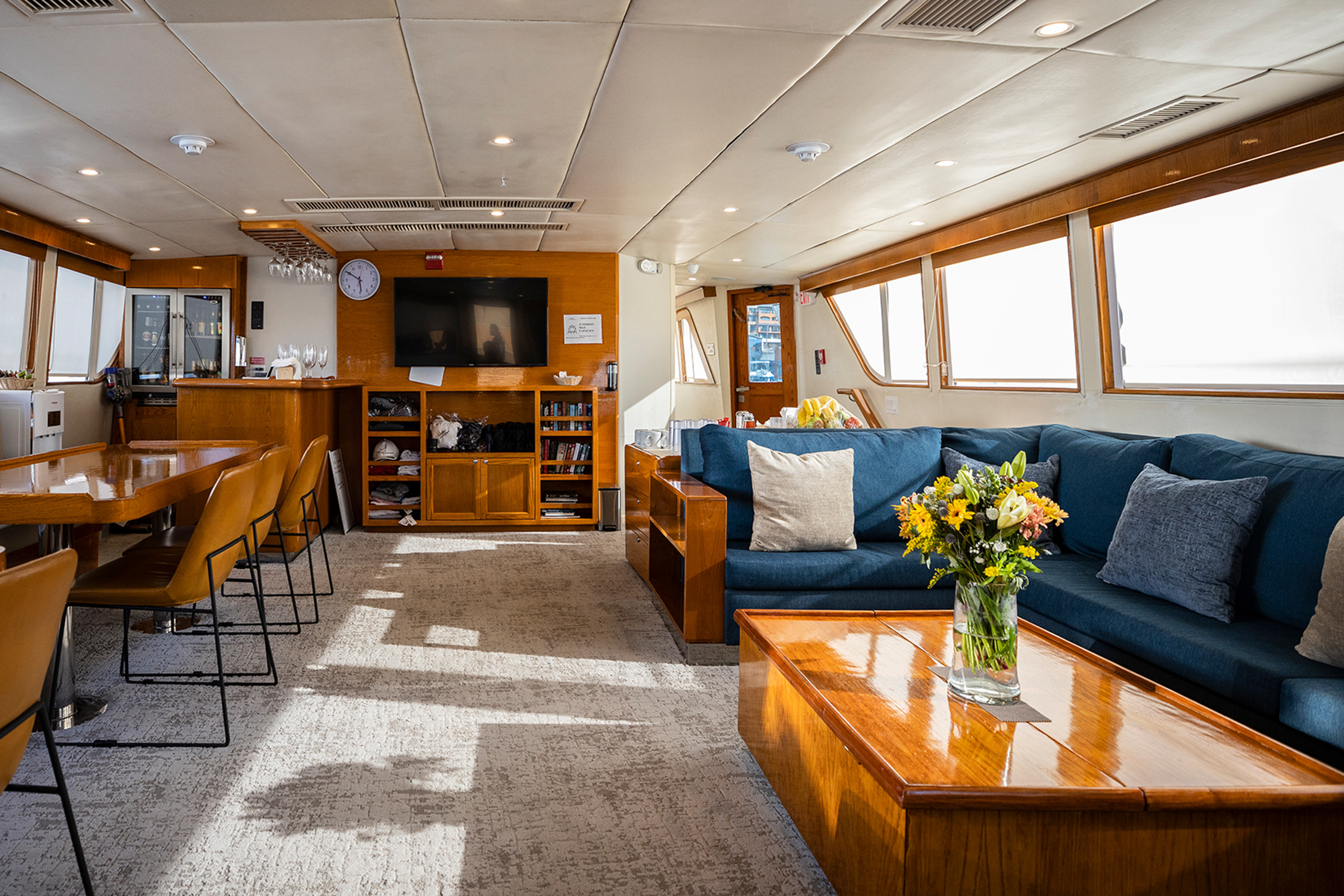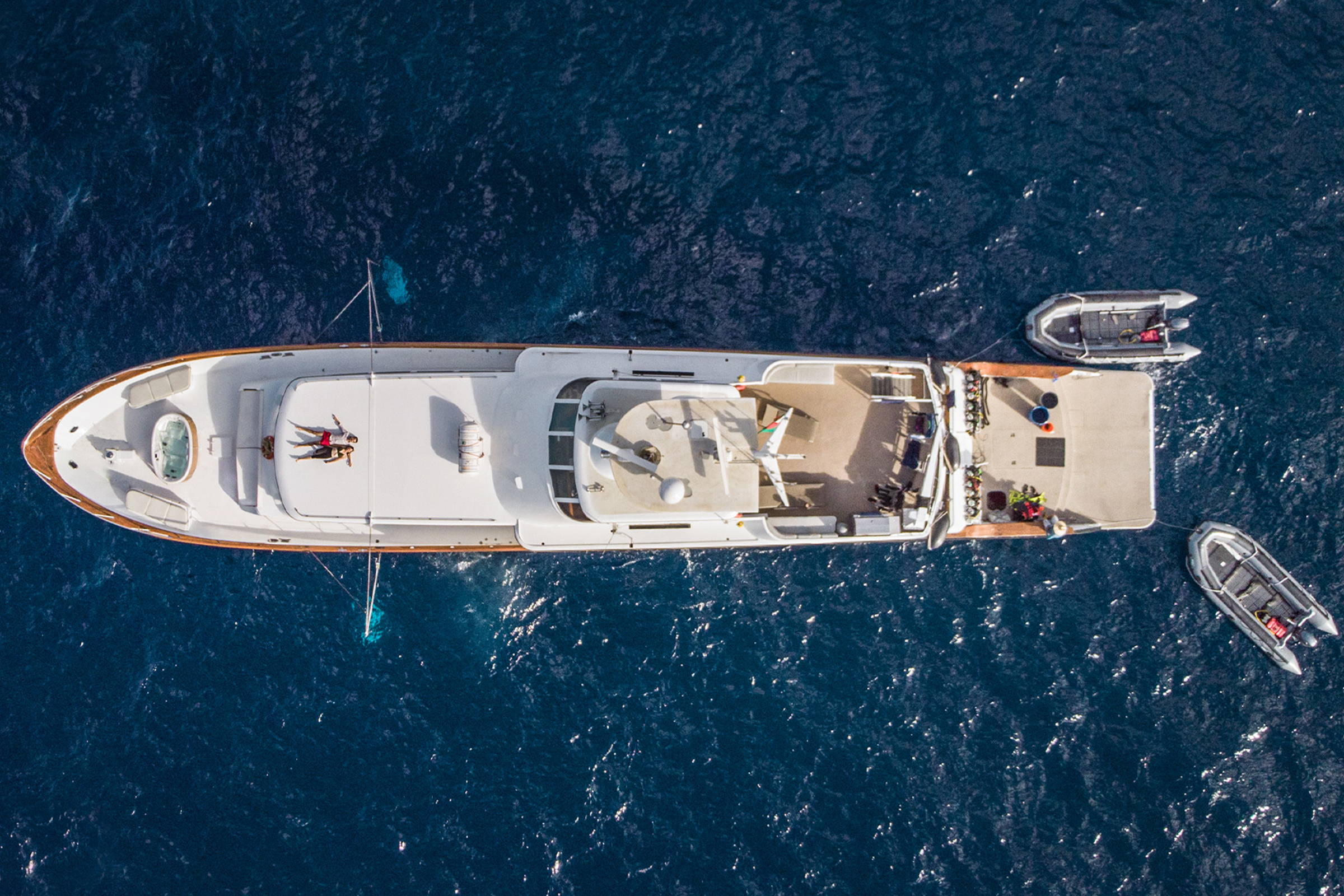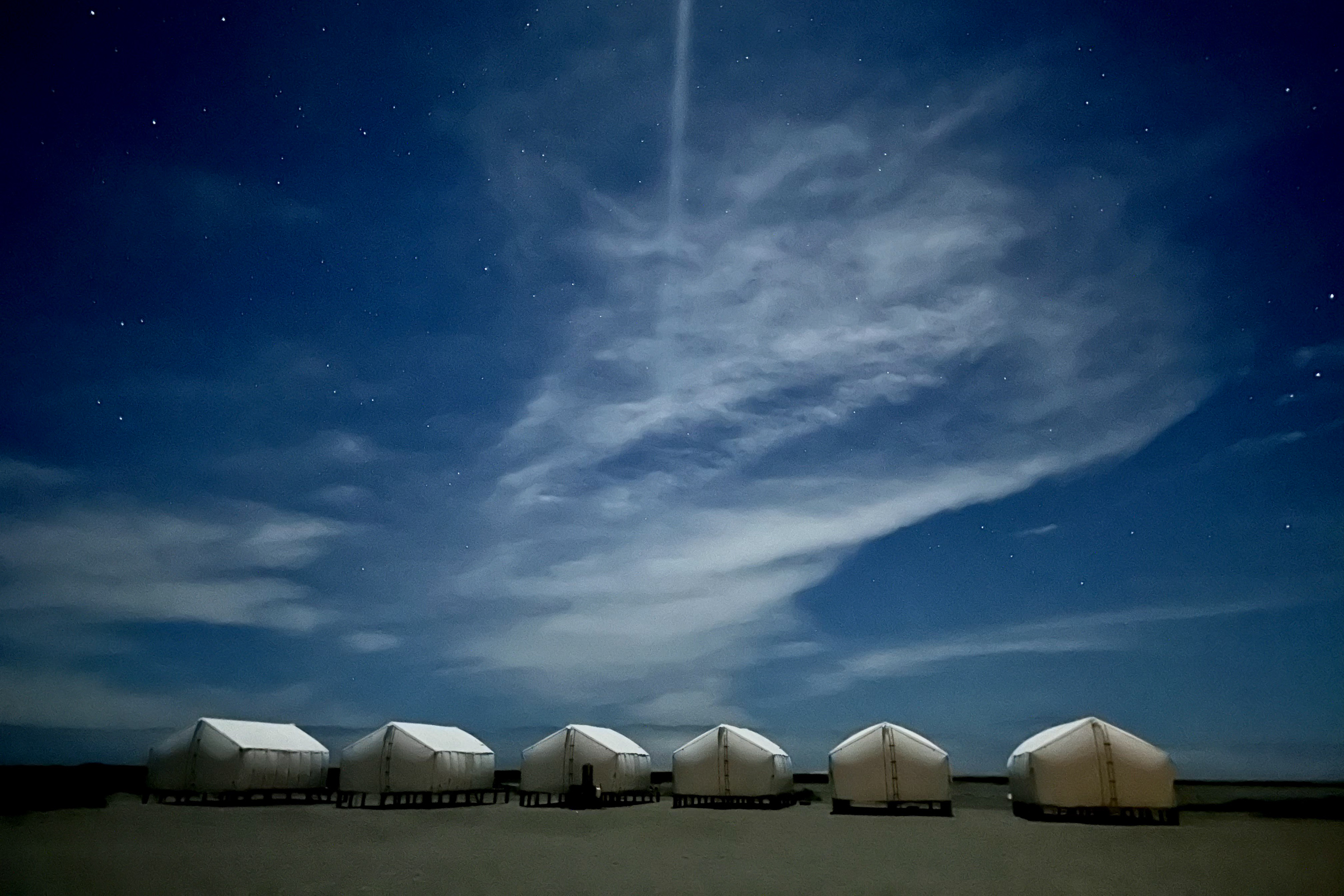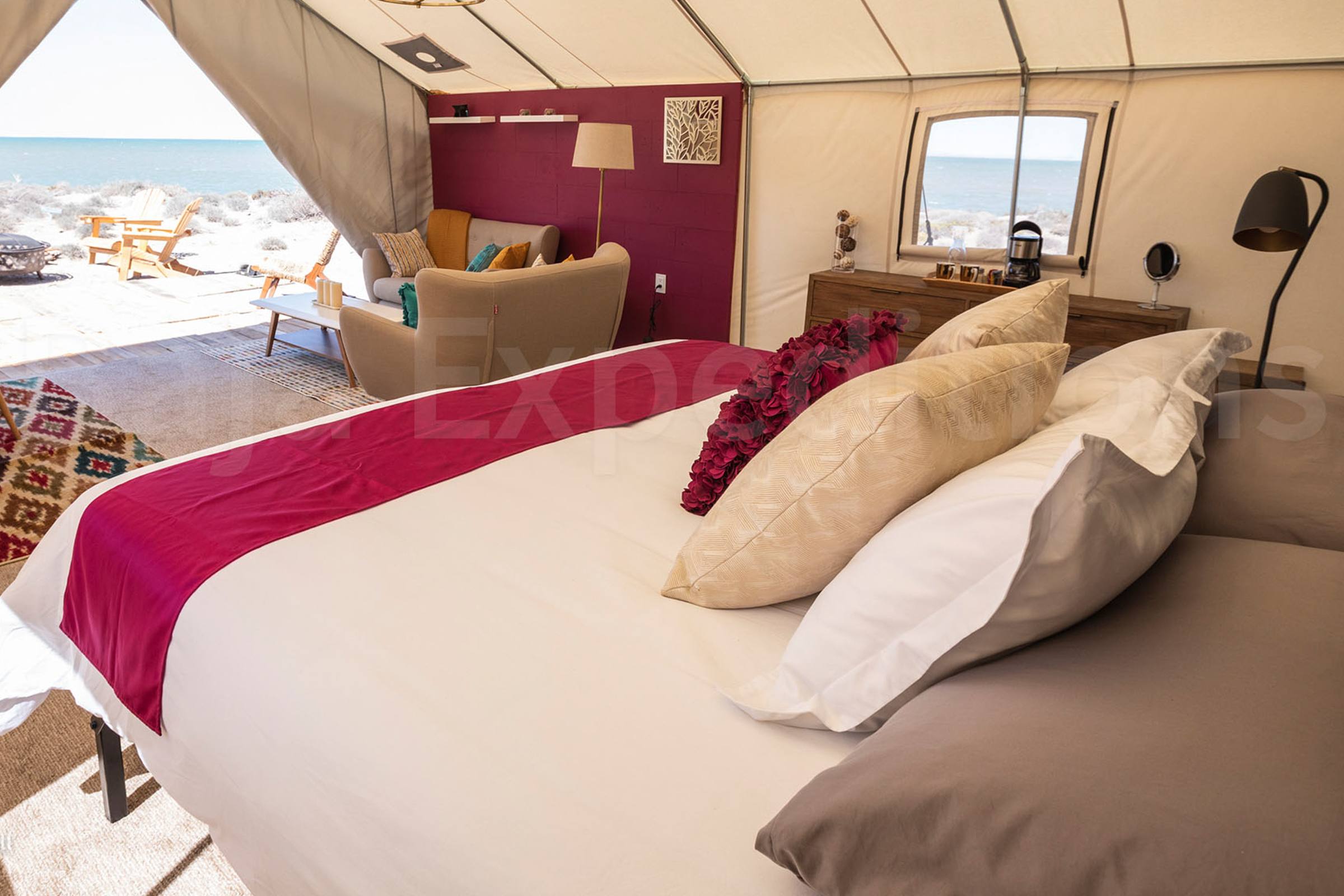7 Days
Baja, Mexico
6 Pax
Easy

Medium
Gray Whales and Blue Whales of Baja Tour
Photograph blue whales and touch gray whales
Our Gray Whales and Blue Whales of Baja Photo Tour will bring you up close and personal with gray whales in San Ignacio lagoon and blue whales in the Sea of Cortez. Prepare to be astonished as friendly gray whales come up to your panga boat to be pet by you (a phenomenon you have to see to believe!), or as they rock the boat while they scratch their backs. Experience the pure jaw-dropping size of 80-foot blue whales as they breed, birth, and feed in the beautiful blue waters of the Sea of Cortez. We will be in the heart of cetacean heaven, having the chance to see over fifteen different species of baleen whales, toothed whales, and dolphins!

COME EYE-TO-EYE WITH GRAY WHALES IN BAJA
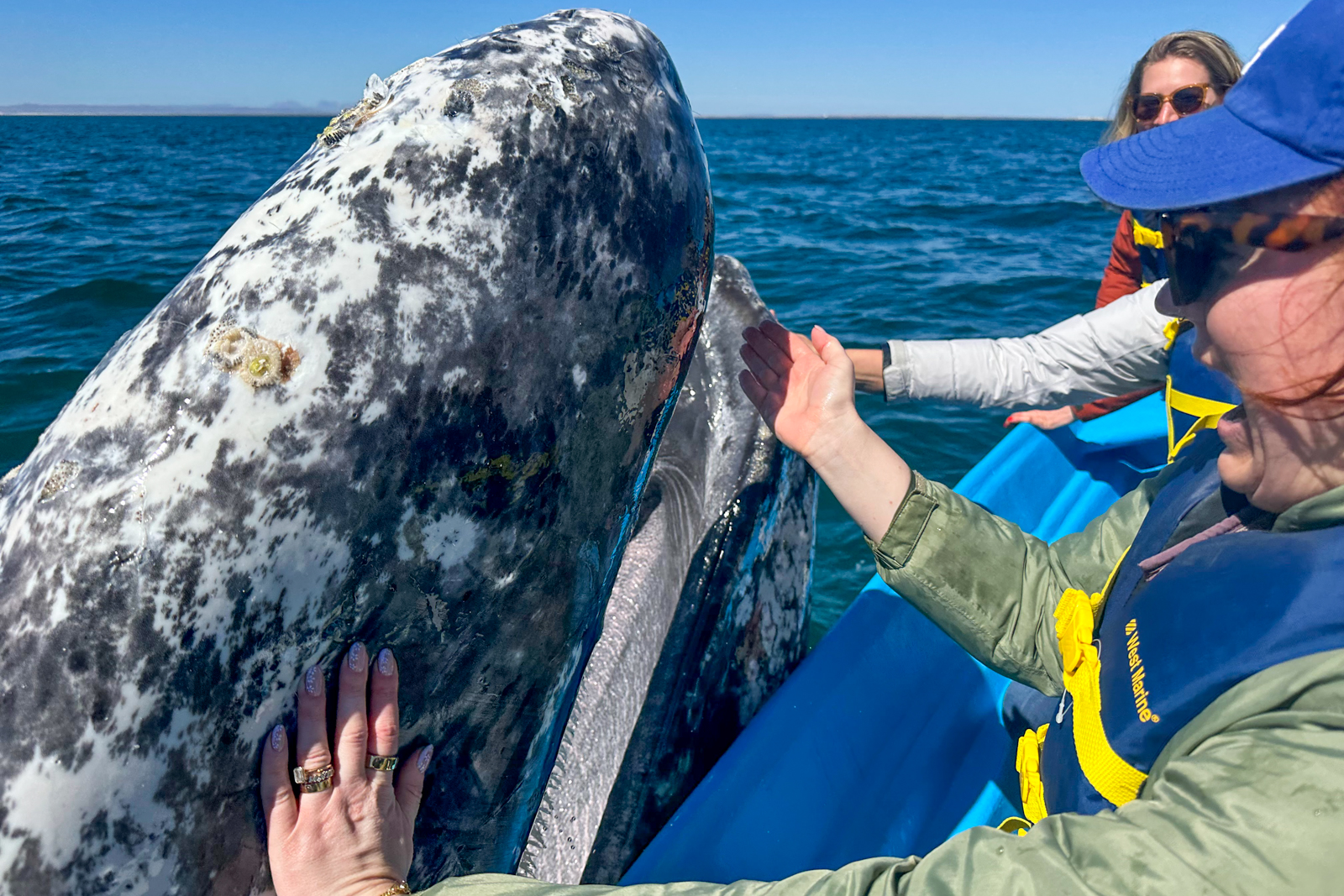
POSSIBILITY TO TOUCH A GRAY WHALE
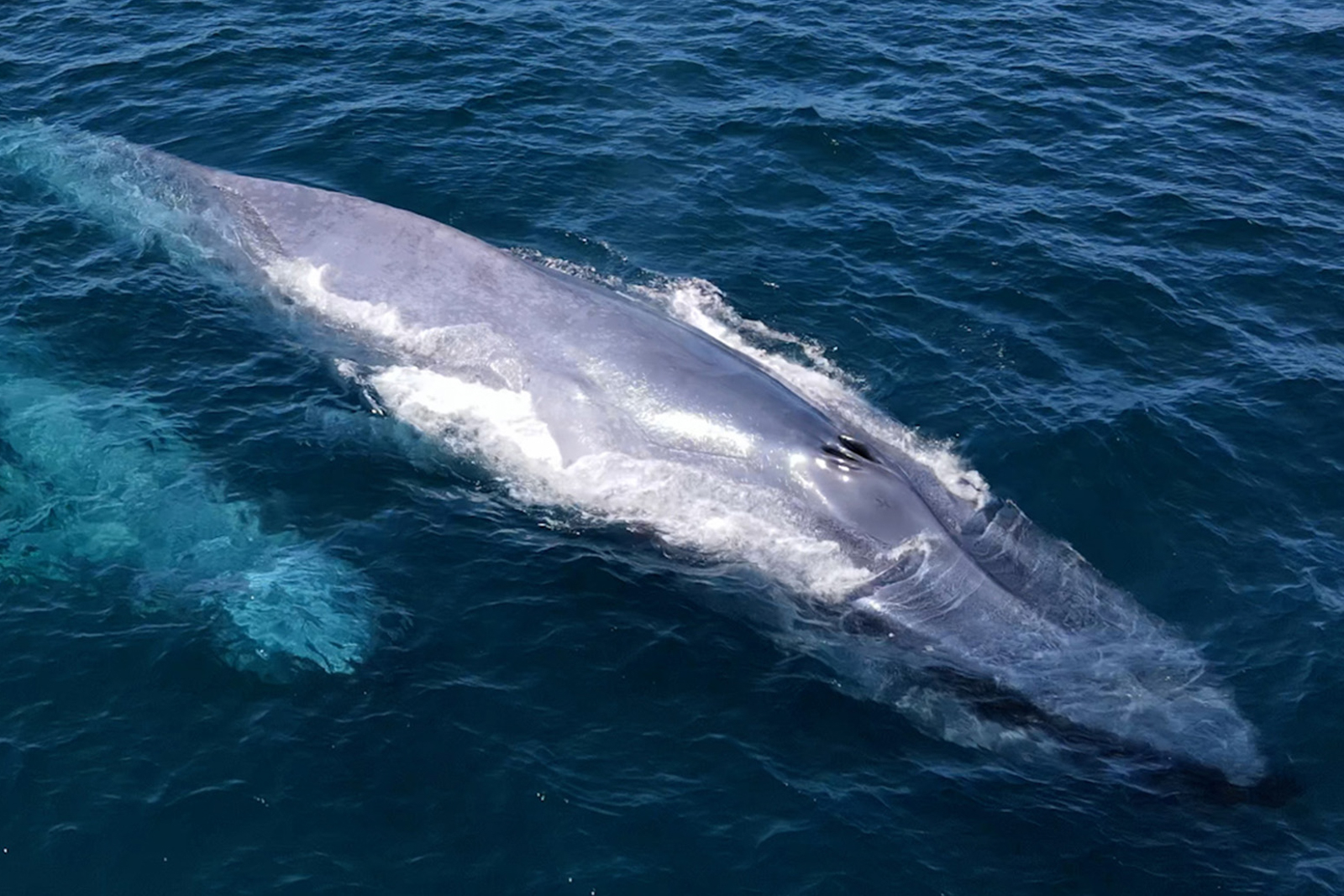
SEE BLUE WHALES AND FIN WHALES
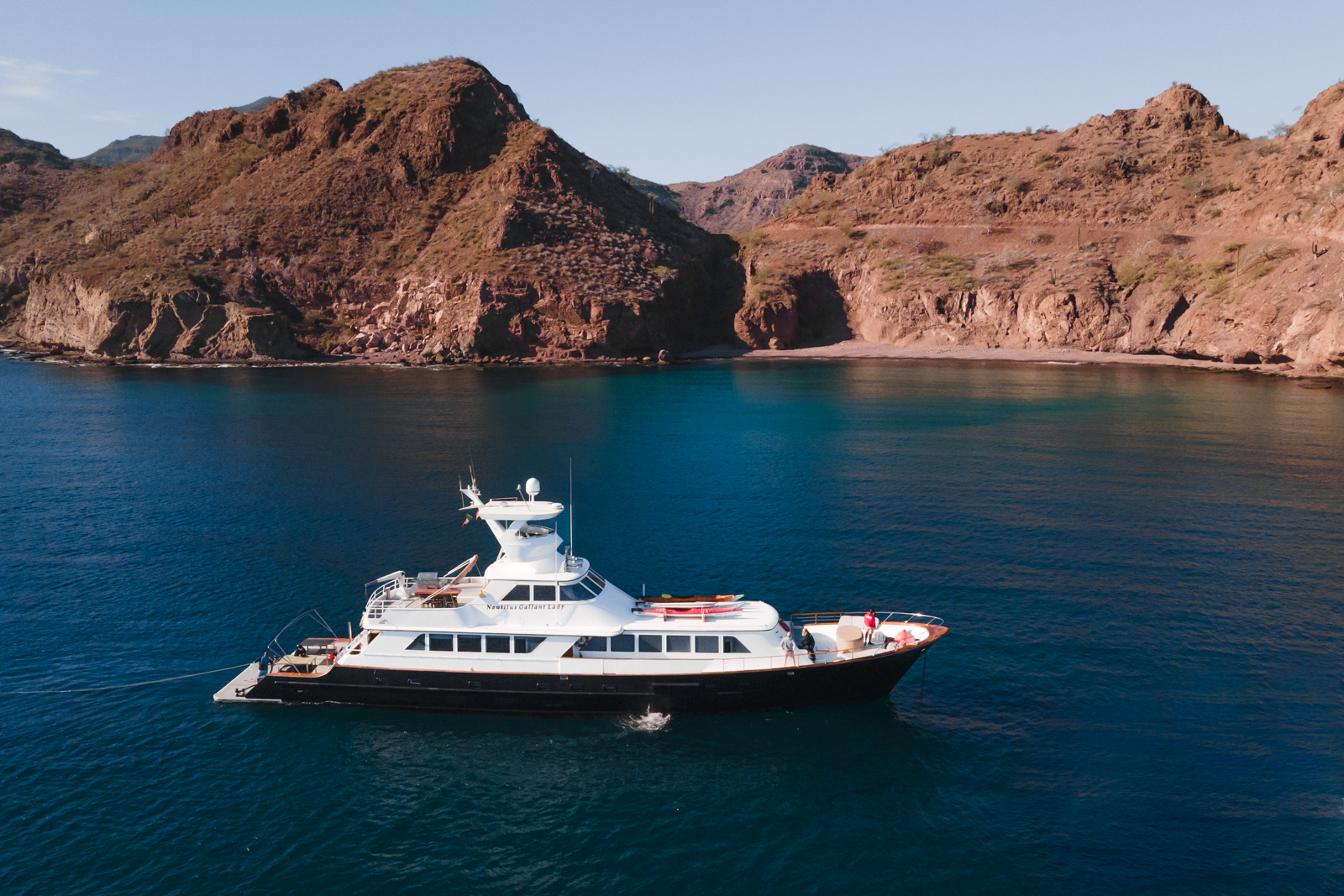
ENJOY EXCLUSIVE USE OF GALLANT LADY YACHT
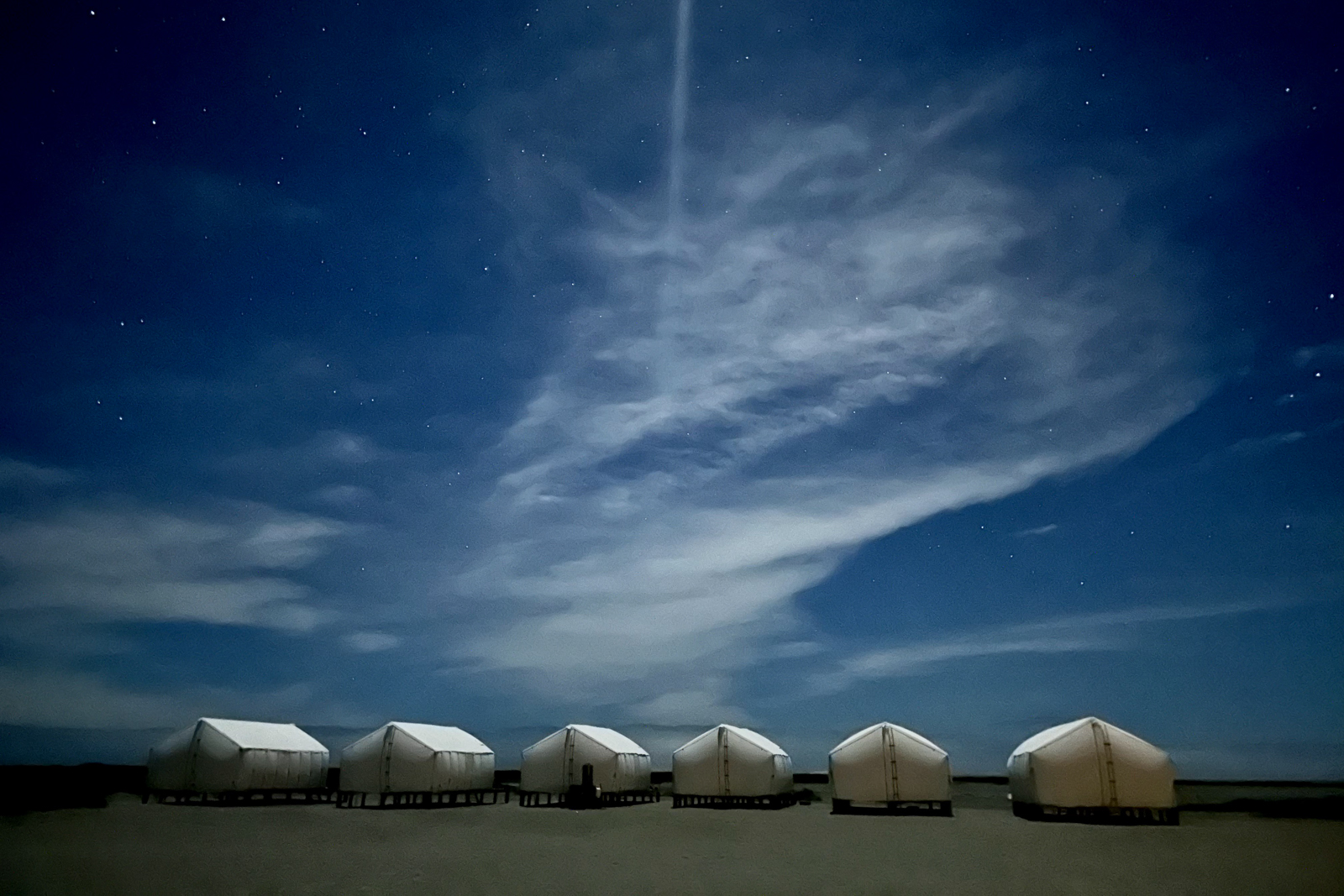
STAY IN LUXURIOUS GLAMPING TENTS
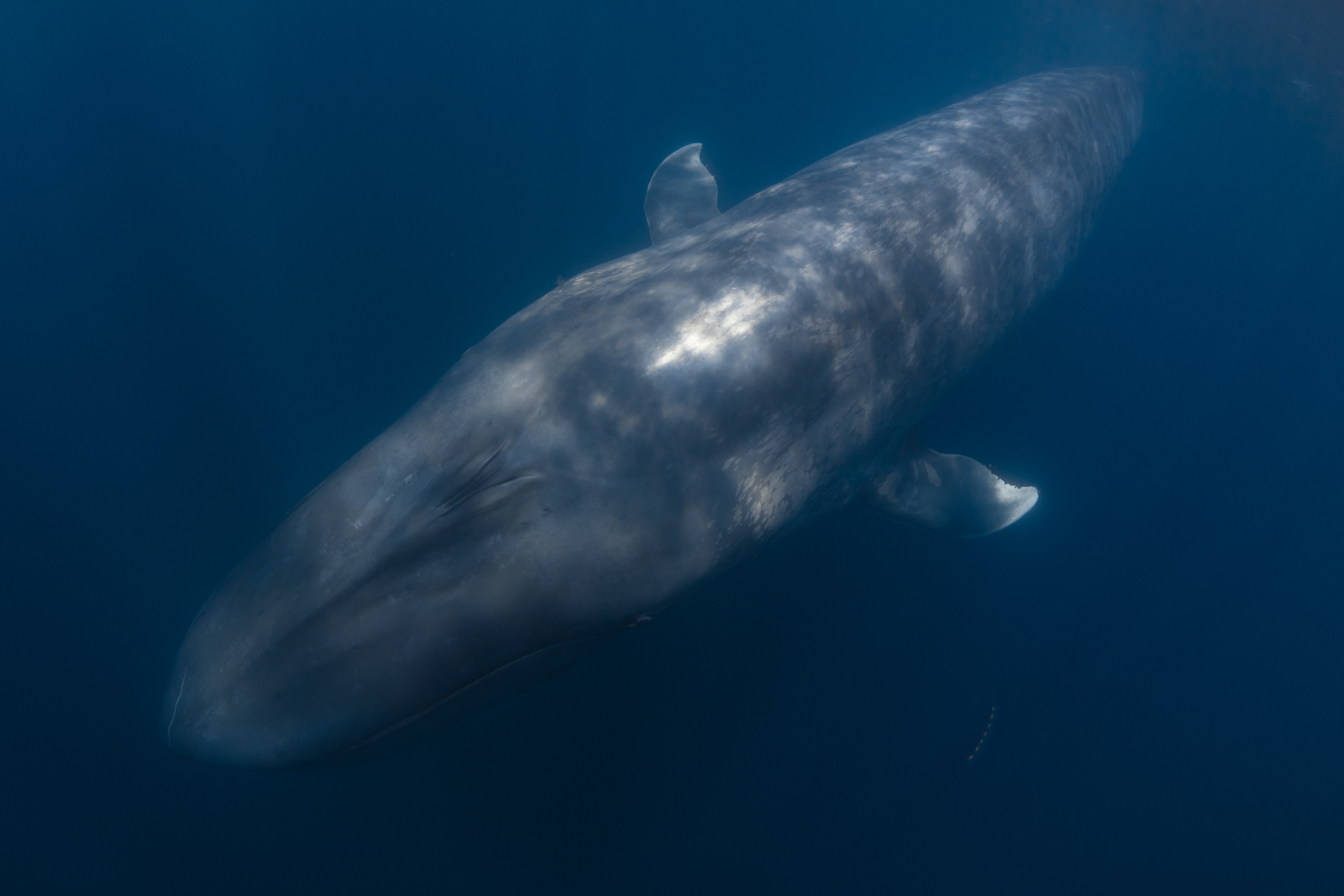
LEARN FROM A CETACEAN EXPERT
Why we love this Gray Whales and Blue Whales in Baja safari
This Gray Whales and Blue Whales in Baja photo tour is designed to give you extraordinary experiences with the different whales of Baja California. This tour takes place during the peak of breeding and birthing season of both the gray and blue whales, to maximize sightings and the possibility of intimate interactions. You'll have experiences at the extremes: seeing the world's largest whales, and (hopefully!) getting to touch a friendly, gray whale.
Intimate encounters with whales are deeply profound, and the gray whales of San Ignacio Lagoon offer an experience unlike anywhere else in the world. At this time of year, the lagoon is what we like to call 'whale soup.' Everywhere you look, you'll see whale blows and spyhopping heads. You'll have the opportunity to be eye-to-eye (literally!) with friendly gray whales, and possibly touch those that seek out more intimate interactions with the boat, a phenomenon unique to this part of the world. This shared moment of mutual curiosity is hard to describe, and exceedingly magical.
Not to mention the power of seeing the world's largest creature: the blue whale! Aboard the 166-foot luxury Gallant Lady yacht exploring the Sea of Cortez, we'll encounter blue whales, fin whales, and other marine fauna. For certain species of marine wildlife (though not baleen whales), we'll often have the possibility to get into the water and experience their beauty up close!
To better understand cetacean behavior, biology and conservation, we'll be joined by a whale biologist on the Gallant Lady. You'll have the opportunity to ask questions and hear stories from a marine wildlife expert as we scour the sea for wildlife!
Gray Whales and Blue Whales in Baja photo tour testimonials
“The gray whale and blue whale tour was one of the most memorable, exhilarating, moving, breathtaking and reflective experiences of my life. You cannot imagine how magical making eye contact and touching a gray whale will be until you do it. I would participate again in a heartbeat. The tour is extremely well organized by Rachel and Sebastian, the glamping tents are very comfortable, the local guides are knowledgeable and friendly and the food was also great. Do not miss out on this once in a lifetime adventure!”
- Teresa Gallet
Other wildlife you can see on this tour
Target whales during our gray whales and blue whales Baja photo tour
GRAY WHALE (Eschrichtius robustus)
Gray whales make the longest mammal migration in the world, traveling from Alaska, south, to northern Baja, Mexico. When they arrive in Mexico, they give birth and breed. During this tour we visit San Ignacio lagoon, the major birthing lagoon for gray whales. During the time of the tour, there are gray whales everywhere. Some of the gray whales even want to be touched by people!
Difficulty: Easy

BLUE WHALE (Balaenoptera musculus)
The world's largest animal to have ever lived, blue whales are simply spectacular measuring up to one hundred feet in length and weighing over one hundred tons. Blue whales come to the Sea of Cortez, also called the Gulf of California to give birth and mate, for just a few weeks each year. This is the time for us to see these incredible giants. These long lived rorqual whales are thankfully increasing in numbers.
Difficulty: Medium

FIN WHALE (Balaenoptera physalus)
The fin whale is the second largest whale in the world, after the blue whale, growing to lengths of eight-five feet. They can be differentiated from their larger cousins by their darker coloration on their dorsal side, with two asymmetric chevron patches near the back of the head. These baleen whales are the fastest whales, reaching speeds up to twenty-five miles per hour. There is a small resident population in the Sea of Cortez.
Difficulty: Difficult

Other possible marine mammals during our safari
HUMPBACK WHALE (Megaptera novaeangliae)
Though common along the pacific coast of North America, humpback whales don't venture far into the sea of Cortez, which means there is a smaller chance of seeing these baleen whales. Please check out our humpbacks of Tonga tour if you want to swim with these gentle giants! We will of course keep an eye out for their distinctive long pectoral fins, and tubercles on its head.
Difficulty: Difficult

BRYDE'S WHALE (Balaenoptera brydei)
The Bryde's whale is a baleen whale similar to the Sei whale. It can be differentiated from other whales by its dark gray dorsal coloration, darker than Sei whales. Their tail flukes barely break the surface, and their spouts are very columnar. Their dorsal fin appears to be in the middle of their back, when surfacing. These whales are found year around in the Sea of Cortez.
Difficulty: Difficult

COMMON MINKE WHALE (Balaenoptera acutorostrata)
Common Minke Whales are the second smallest species of baleen whale in the world, and the smallest baleen whale we can encounter on this tour. Their relatively large, sickle-shaped, dorsal fin is a distinctive identifying marker. They are present in the Sea of Cortez from December through April so we will keep an eye out for these rorqual whales.
Difficulty: Very Difficult

SEI WHALE (Balaenoptera borealis)
The Sei Whale is very similar in appearance to the Bryde's Whale, and is more rare in the Sea of Cortez, than its slightly smaller cousin. It is dark, steely gray in its ventral coloration. Its dorsal fin is slightly more upright than the Bryde's Whale and appears further back on its body. These whales are classified as endangered and we would be thrilled to see any individuals during our tour.
Difficulty: Very Difficult

COMMON DOLPHIN (Delphinus delphis)
These medium sized dolphins are unique in their coloration, having a yellow or golden hourglass on the sides of their bodies. These dolphins can form large pods, over a hundred individuals and can sometimes even create super-pods, when multiple pods come together at the same time. They are found year around in the Sea of Cortez.
Difficulty: Easy

SPINNER DOLPHIN (Stenella longirostris)
Spinner dolphins are small, slender-bodied, dolphins known for their acrobatic displays of leaping and spinning when breaching. Unlike most other dolphins, spinner dolphins are nocturnal, hunting squid and fish at night, rather than during the day. They are one of the more rare dolphins in the Sea of Cortez.
Difficulty: Difficult

SHORT-FINNED PILOT WHALE (Globicephala macrorhynchus)
Despite their name, Short-finned Pilot Whales are dolphins. They can be distinguished from other dolphins in the Sea of Cortez by their larger size, bulbous head, and sickle-shaped dorsal fin. They are generally found in deeper waters, preferring to go for prey off the continental shelf.
Difficulty: Very Difficult

RISSO'S DOLPHIN (Grampus griseus)
The unique looking Risso's Dolphin has a large bulbous head, with a quickly tailoring body towards its tail. Its dark gray colored body is often marked by white scratches. They are mostly nocturnal, feeding on squid off of the continental shelf. They are found in the Sea of Cortez all year around.
Difficulty: Difficult

PANTROPICAL SPOTTED DOLPHIN (Stenella attenuata)
The Pantropical Spotted Dolphin is a fairly slender, streamlined dolphin. It has light spots on its body that increase in number and size as it gets older. The coastal spotted dolphins in the Sea of Cortez are larger than the pelagic populations. They are one of the more obvious dolphins as they are very active, and leap and splash a lot.
Difficulty: Medium

ORCA (Orcinus orca)
Orcas are the largest members of the dolphin family. They are mostly black in coloration with white markings behind the dorsal fin, chin, and lower body. Male orcas have a very large, straight dorsal fin. They are apex predators, capable of hunting prey much larger than themselves. If you want to target Orca in the Sea of Cortez check out our Orcas and Mobula Rays photo tour.
Difficulty: Difficult

FALSE KILLER WHALE (Pseudorca crassidens)
The name of the false killer whale comes from its skull's appearance being similar to that of the orca. False killer whales have slender bodies with an elongated, tapered head. They are black or dark gray in coloration with a slightly lighter ventral side. They are the third largest dolphin in the Sea of Cortez, reaching sixteen feet in length.
Difficulty: Very Difficult

PACIFIC WHITE-SIDED DOLPHIN (Lagenorhynchus obliquidens)
The Pacific white-sided dolphin is an average sized dolphin that has three different colors. The belly, throat, and chin, are creamy white. The back, flippers, and beak are dark gray. On the sides of their bodies, they have light gray patches and an additional light gray stripe. They are only found in the southern part of the Sea of Cortez.
Difficulty: Very Difficult

STRIPED DOLPHIN (Stenella coeruleoalba)
The Striped Dolphin is similar in size to the Pantropical spotted dolphin, but can easily be distinguished from it by its markings. Black bands circle the eyes, which then run across the back. Two further black stripes run from behind the ear down its side of its body. One runs along its body toward the tail, the other ends just at the flipper.
Difficulty: Difficult

ROUGH-TOOTHED DOLPHIN (Steno bredanensis)
The Rough-toothed Dolphin is a large dolphin species with a distinguishing conical head and slender nose. The body is black dorsally and light gray and white ventrally. The lower jaw of the Rough-toothed Dolphin is white in color. They will sometimes join other pods of dolphins or may create large pods amongst themselves.
Difficulty: Difficult

COMMON BOTTLENOSE DOLPHIN (Tursiops truncatus)
The Common Bottlenose Dolphin is the most well known dolphin species, as it is the species most commonly found in aquariums and was the dolphin on the show flipper. It is a medium size dolphin, uniformly light gray in coloration, with a short beak. It is one of the more common dolphin species found in the Sea of Cortez.
Difficulty: Easy

DWARF SPERM WHALE (Kogia sima)
The dwarf sperm whale is the smallest of the three sperm whales, with a length of about eight feet. It has a dark-gray or blue-gray color with a lighter-grey ventral side. It has a pale, crescent-shaped mark between the eye and the flipper, just like the pygmy sperm whale. The squared head is the differentiator between the two smaller sperm whales.
Difficulty: Extremely Difficult

PYGMY SPERM WHALE (Kogia breviceps)
The pygmy sperm whale is slightly larger than the dwarf sperm whale and is lighter in color. Its underside can also often be pink, unlike the dwarf sperm whale. The head of the pygmy sperm whale looks shark like, which is the best way to tell this species from the other two sperm whales.
Difficulty: Extremely Difficult

SPERM WHALE (Physeter macrocephalus)
Sperm whales are the largest toothed whales, with a length of about fifty feet. The easiest way to tell them apart from other whales is by their very large, block-shaped head. Their blowhole is also skewed to the left side of their body. Rather than smooth skin, the sperm whale's skin looks like a dried fruit.
Difficulty: Difficult

BLAINVILLE'S BEAKED WHALE (Mesoplodon densirostris)
Blainville's Beaked Whale have slender, long bodies that are steely-blue in coloration. They are often covered with lighter blotches, potentially caused by cookie-cutter sharks. Like all beaked whales, Blainville's beaked whales forage in deep waters and are rarely seen at sea.
Difficulty: Extremely Difficult

BAIRD'S BEAKED WHALE (Berardius bairdii)
Baird's Beaked Whales are the largest beaked whale and the second largest toothed whale. Their bodies are brownish-grey, while their foreheads turn white as they age. Their unique underbite, with the lower jaw having two pairs of teeth is a unique identifier for this species. Like other beaked whales Baird's beaked whales are extremely rare to see.
Difficulty: Extremely Difficult

CUVIER'S BEAKED WHALE (Ziphius cavirostris)
Cuvier's Beaked Whales are dark gray dorsally and have lighter bellies and heads. Along with their dark eye rings, look for the numerous scars that cover their body from their prey and from fighting. Cuvier's beaked whales have the longest and deepest recorded dives from any mammal of the world.
Difficulty: Extremely Difficult

![]() Easy: for the duration of the trip we will have multiple encounters with this whale or dolphin species with good photo opportunities
Easy: for the duration of the trip we will have multiple encounters with this whale or dolphin species with good photo opportunities
![]() Medium: we expect to see the cetacean and have at least one, but probably multiple encounters, with good photo opportunities
Medium: we expect to see the cetacean and have at least one, but probably multiple encounters, with good photo opportunities
![]() Difficult: for the duration of the trip, our goal will be to have one encounter with good photographic opportunities
Difficult: for the duration of the trip, our goal will be to have one encounter with good photographic opportunities
![]() Very Difficult: for the duration of the trip we hope to have one encounter with the whale or dolphin species, whether a good photo opportunity or not
Very Difficult: for the duration of the trip we hope to have one encounter with the whale or dolphin species, whether a good photo opportunity or not
![]() Extremely Difficult: it is extremely unlikely to see this whale or dolphin species, so having even a glimpse of it is considered success
Extremely Difficult: it is extremely unlikely to see this whale or dolphin species, so having even a glimpse of it is considered success
You are in good hands, we are gray whale and blue whale experts
We have chosen the best location at the perfect time of year for our gray whale and blue whale photo tour. More importantly we utilize the best gray whale and blue whale guides to increase our chances of seeing the cetaceans.
We have handpicked the best local guides who have spent years on the Sea of Cortez and San Ignacio lagoon, searching for and experiencing the whales. Their vast knowledge will tremendously increase our chances of finding and having memorable interactions with these whales. We will also have a whale biologist on board the Gallant Lady, ensuring that any and all of your whale questions are answered throughout this part of the trip. Finally, your international whale and photography guides are Rachel Tobias and Sebastian Kennerknecht who have both traveled to Baja to photograph its whales. They will help you along every step to guide you through any photography challenges you may face.
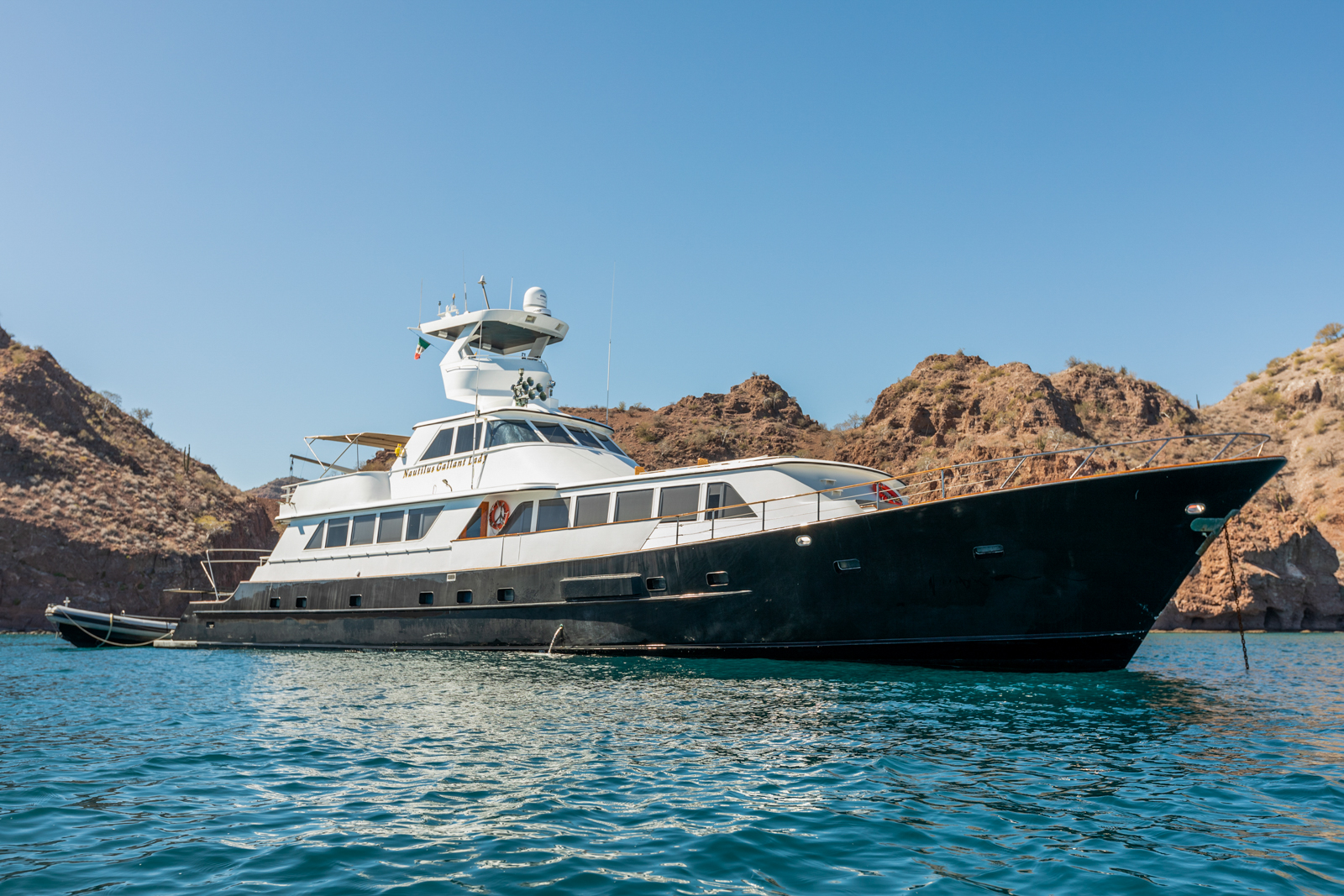
Day 1
Arrive in La Paz, Mexico. You will be picked up by the Whale Expeditions team and be driven to the Gallant Lady. Upon everyone's arrival we will depart dock and start looking for blue whales, fin whales, and all the other cetaceans the Sea of Cortez has to offer.
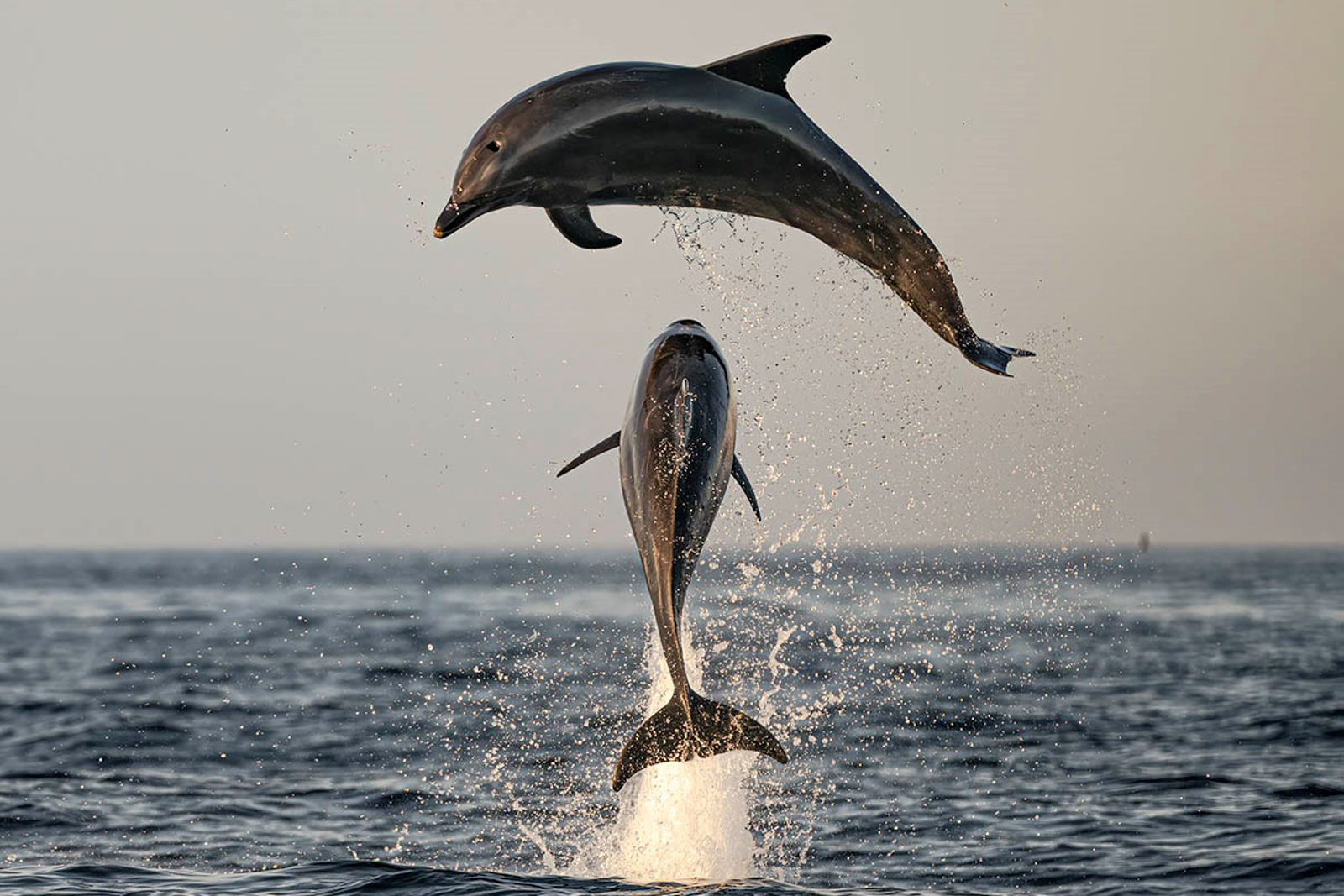
Day 2-3
We will have exclusive use of the Gallant Lady Yacht and will be looking for whales, dolphins, and other marine life throughout the days. With certain species we will have the chance to enter the water and share their home. For other species we will enjoy the views from the boat. We have a chance to see over twenty different marine mammals! Breakfast, lunch, and dinner will be served on the boat, or we may find our own private little beach.
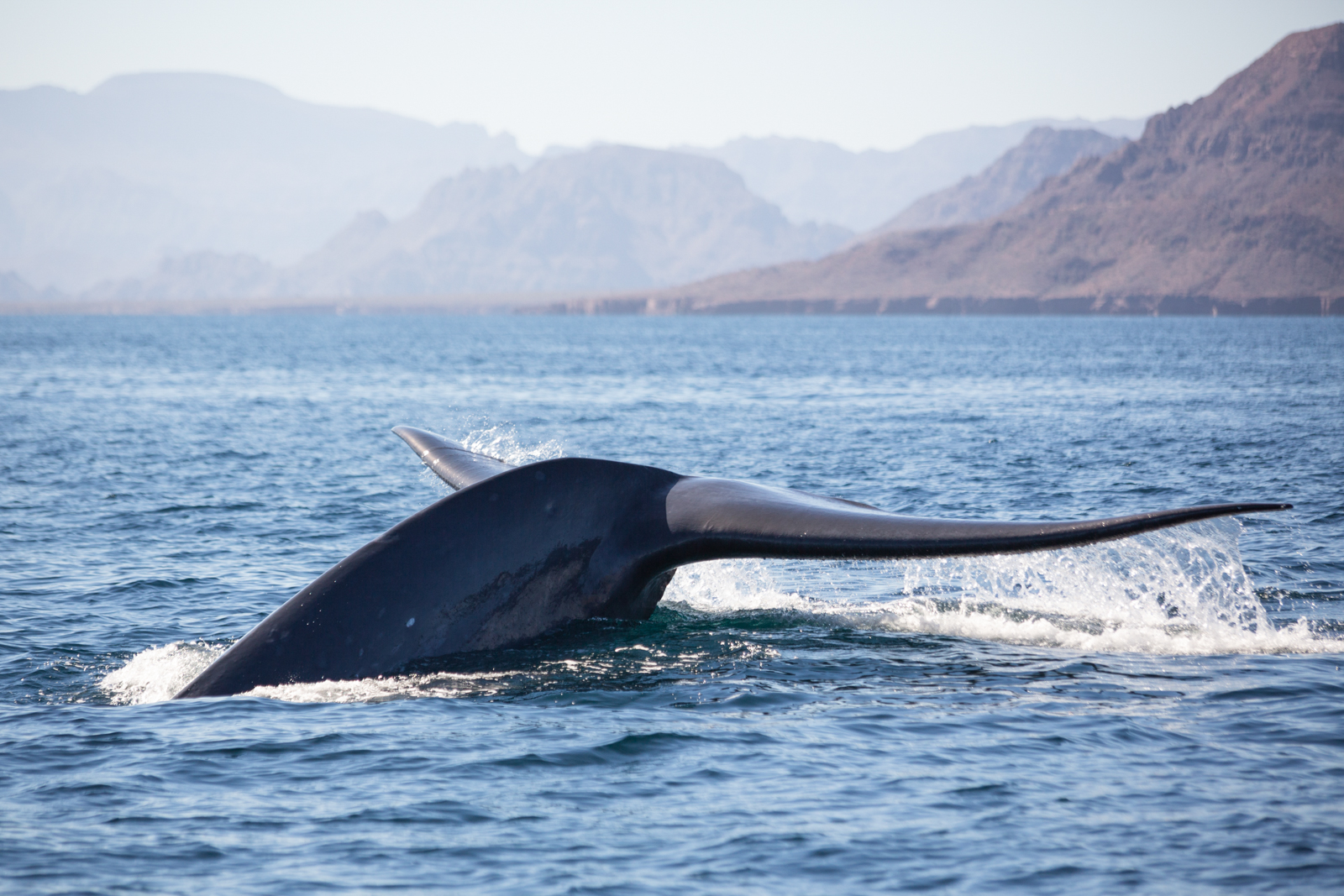
Day 4
After a last chance to spot and photograph blue whales in the Sea of Cortez and a breakfast on board the ship, we catch our charter flight to San Ignacio Lagoon in northwestern Baja. We will take a panga ride to our tented camp, drop our bags, and then go out into the lagoon for our first gray whale outing.
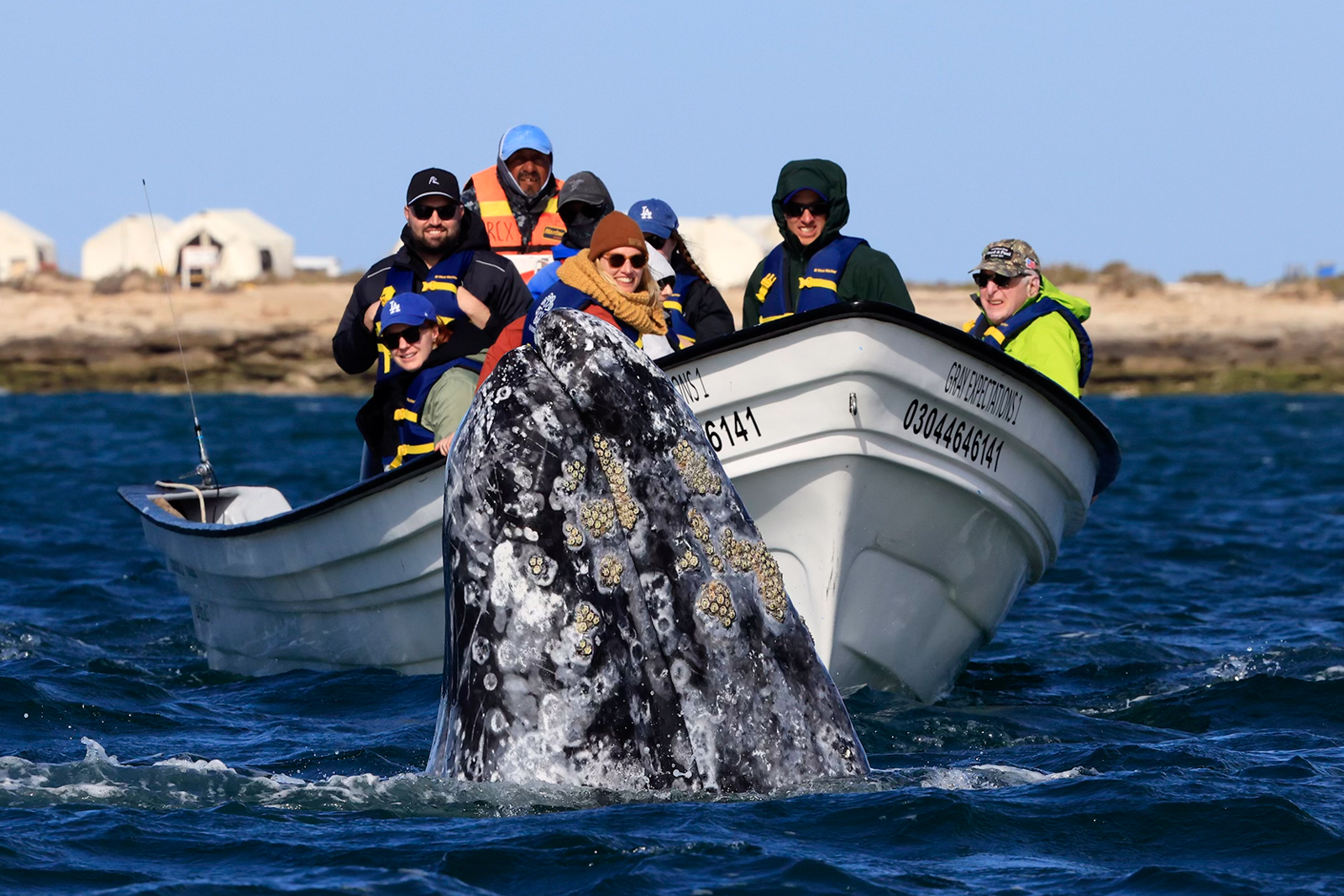
Day 5-6
After an early breakfast, we will go out in one panga boat to look for gray whales and hope for the chance to encounter a friendly individual that wants to be touched. We do two, 3-hour sessions on the water: one in the morning and one in the afternoon, with a 30-minute beach break in the middle of each session. We have a break at camp for lunchtime, and breakfast and dinner also back at camp.
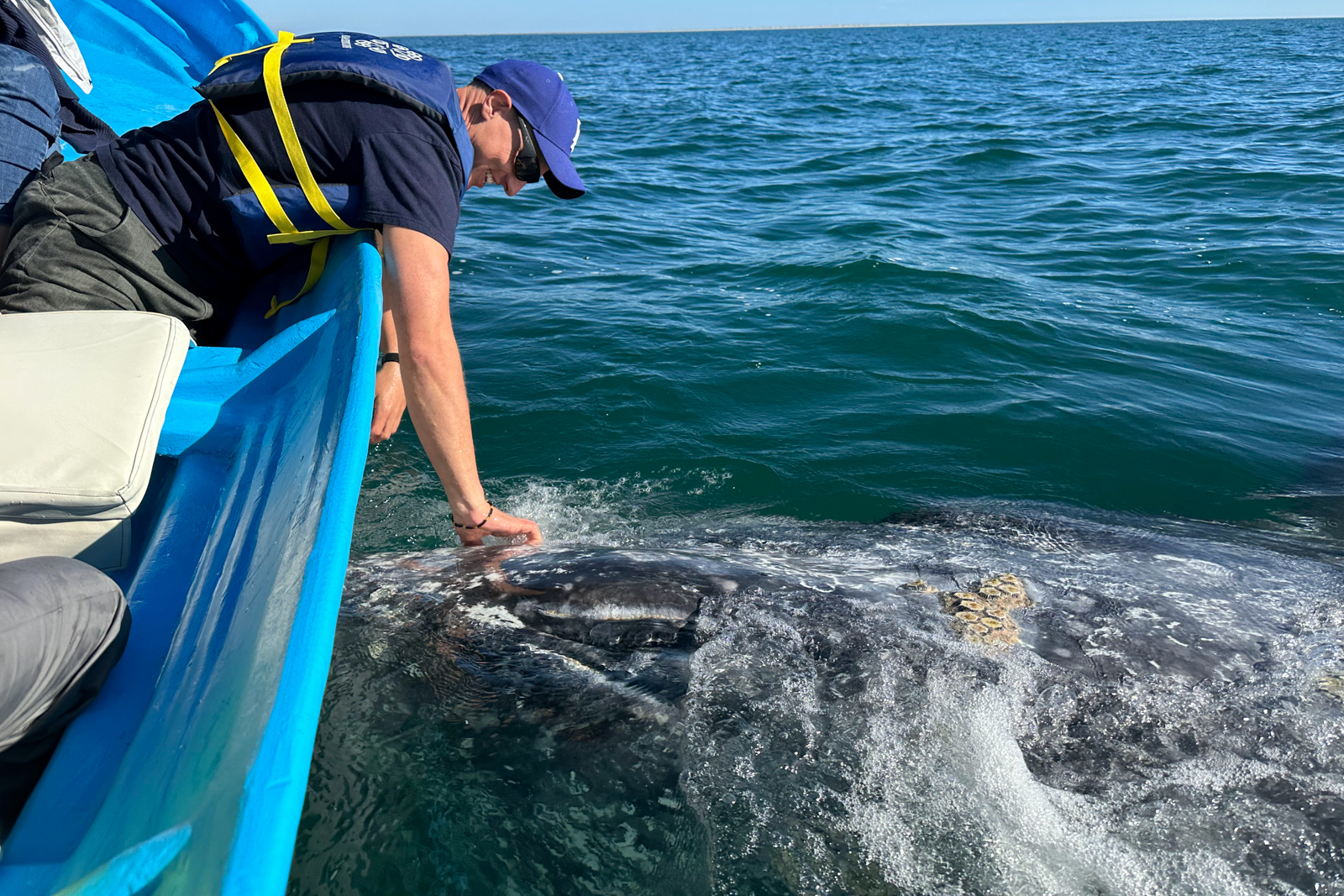
Day 7
One last morning session with the gray whales in San Ignacio lagoon, before fly back to Cabo San Lucas, from where you catch your onward international flights.
Itinerary at a glance
6 NIGHTS
7 DAYS
1 YaCHT
1 Tent camp
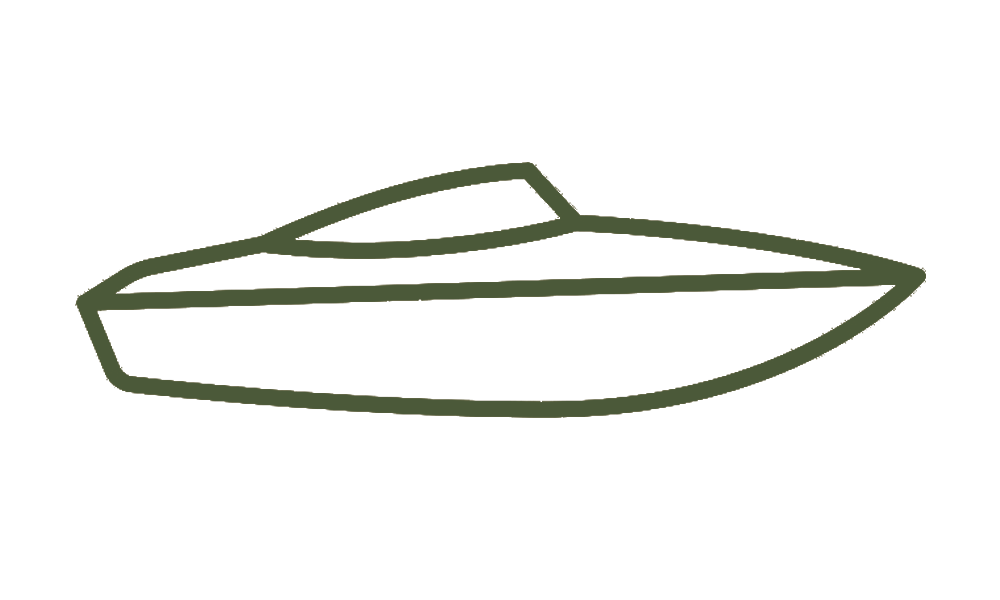
12 cetacean safaris
sheltered ocean
lagoon
3 Baleen whales

yacht safaris
panga safaris
snorkeling
Experiencing blue whales and petting gray whales
Our gray whales and blue whales of Baja photo tour is designed for you to have two incredible whale experiences. To get awed by the incredible size of blue whales and to have intimate connections with gray whales.
Seeing the world's largest animal that has ever lives, the blue whale, is truly humbling. When a blue whale surfaces and exhales from its blowhole the sound along is breathtaking. Getting to see and appreciate the true size of these animals in the crystal blue waters of the Sea of Cortez makes it even more special.
The first time we went to see the gray whales in San Ignacio lagoon, we just giggled. Gray whales are everywhere. Furthermore, wildlife doesn't normally come up to you to want to be pet or scratched. Yet, in San Ignacio lagoon, a small percentage of the gray whales that come there every year, want just that. The whales approach the panga boat, often first scratching themselves on its hull, then lift their head out of the water next to the boat, asking for petting. If you don't comply, they will move on to a different boat that does. If you have a really friendly whale, it will play and interact with you. Once we had a whale seemingly purposefully turn to spray us with its blowhole. It stayed with the boat for over forty minutes, demanding petting and spraying us.
The Sea of Cortez, also known as the Gulf of California, is a marine life hot spot. Over twenty cetaceans call this ocean home, plus other marine mammals like sea lions. Whale sharks are always a possibility to encounter and snorkel with. No matter what, we have a fantastic time exploring the beautiful waters and coastline of the Baja California peninsula.
Besides providing you the opportunity to see and photograph whales, we at Whale Expeditions make your travel experience hassle free. You will be sent a full itinerary that includes what to bring and how to prepare. Once you land in La Paz, you can focus on enjoying yourself as all the travel logistics are not only taken care off, but optimized to give you the most time to enjoy the incredible wildlife that the Sea of Cortez and San Ignacio Lagoon have to offer.
Gallant Lady
The Nautilus Gallant Lady is part of the Nautilus liveaboard fleet. The 166ft luxury yacht caters to just our group in six large suites. Cabins are located on the lower and main decks. Each room features individually controlled AC, a California King or two double beds, ample storage space, and private en-suite bathrooms.
The Gallant Lady has been thoughtfully designed with plenty of comfortable social areas to unwind. The sky lounge with a hot tub on the top deck is the perfect place to enjoy a cocktail at the end of the day, and the sundeck is a great place to relax. The main salon and dining room feature a fully stocked bar and wrap-around views. The onboard chef prepares a fusion of fresh Mexican and West Coast North American cuisine, and all dietary requirements can be catered for with advance notice.
The Gallant Lady has low-speed internet. No laundry service is available.
Tented Camp, San Ignacio Lagoon, Baja, Mexico
To follow environmental rules, no structures in San Ignacio lagoon can be permanent. This means that every winter, tents are brought in for the whale season, and removed again once the whales depart. This ensures minimal impact on the ecosystem. The tented camp is glamping at its best. You can easily stand up in and move around in the large, windproof tents.
The tents are insulated and heated to ensure maximum comfort. Each tent as its own ensuite bathroom and shower with hot water. Each tent also has 24 hour power. The beds are “real beds” with fine linen.
In addition to a dining tent with delicious food, the camp also has a bar and lounge tent with games, presentations and comfortable seating to decompress after a day of whale-watching.
Tented Camp has high-speed internet and laundry service is available at a small cost to the client.
-
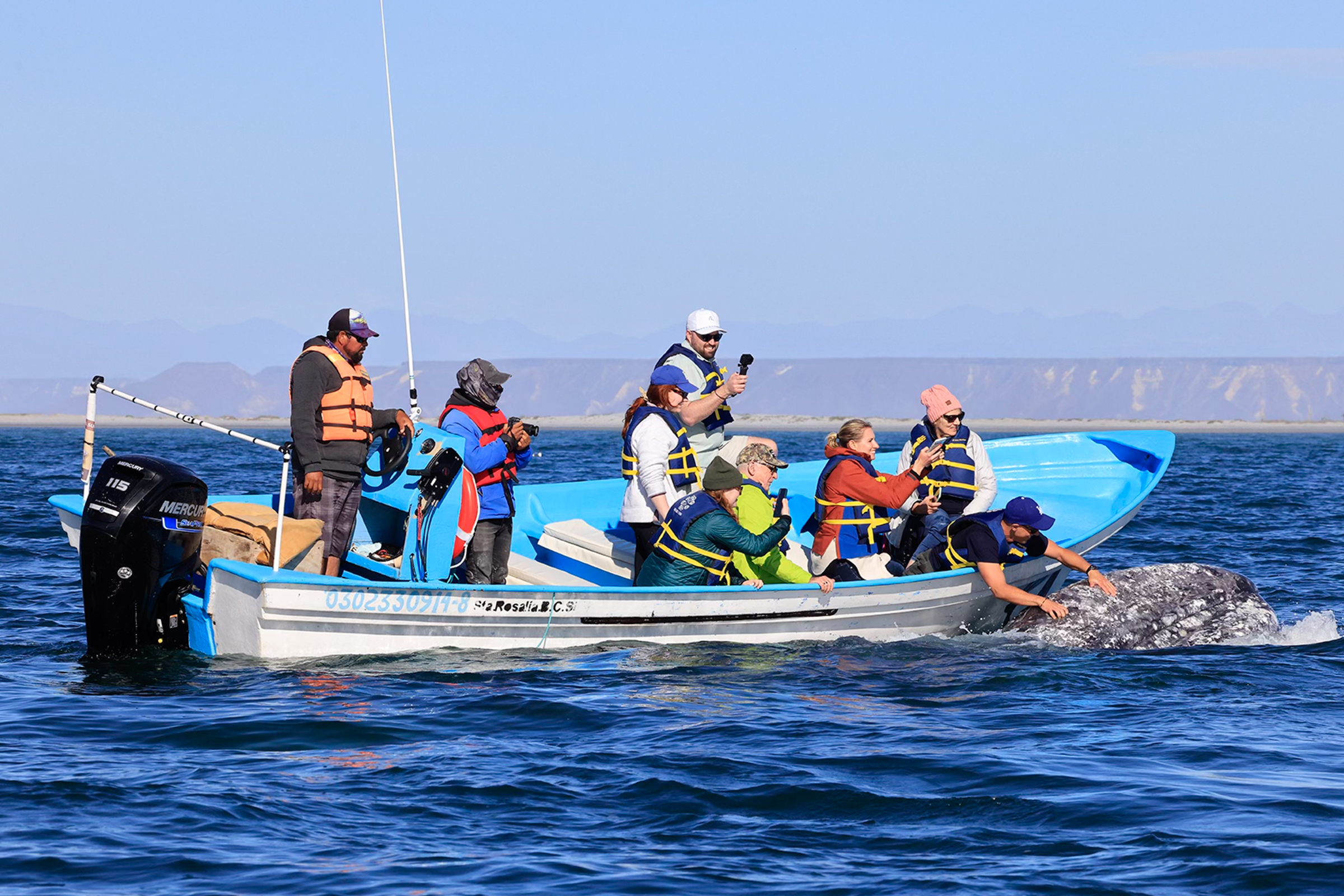 Pangas at tented camp, San Ignacio Lagoon, Baja,...
Pangas at tented camp, San Ignacio Lagoon, Baja,...
Conservation impact of our gray whales and blue whales of Baja photo tour
Like all Whale Expeditions tours, our gray whales and blue whales of Baja photo tour has conservation impact built into it. Blue whales are classified as endangered, and the eastern Pacific population only has around two thousand adult animals. Their main threats are ship wrecks and fishing gear entanglement.
To better understand whales, their ecology, and their threats we will have a whale expert on the Gallant Lady, who will provide all the information you could ever want on whales. To help combat ship collisions we are donation part of the tours cost to WhaleSafe, who actively monitor whale presence in shipping channels and provide guidance to ships on how to avoid the cetaceans.
Conservation at a glance
Gray Whales and Blue Whales in Baja Photo Tour Dates
2027 Dates to be Determined (around early March) (6 spots available)
Gray Whales and Blue Whales in Baja Photo Tour Pricing
Price per person: $9,400
Single room supplement: $1,400
The price includes:
- all transportation starting in Mexico
- lodging
- meals (not including alcohol)
- whale excursions
- guide services of Rachel Tobias
- guide services of Sebastian Kennerknecht
- guide services of local guide
- conservation donation
The price does not include:
- flights to Mexico
- tips
- laundry
- insurance
